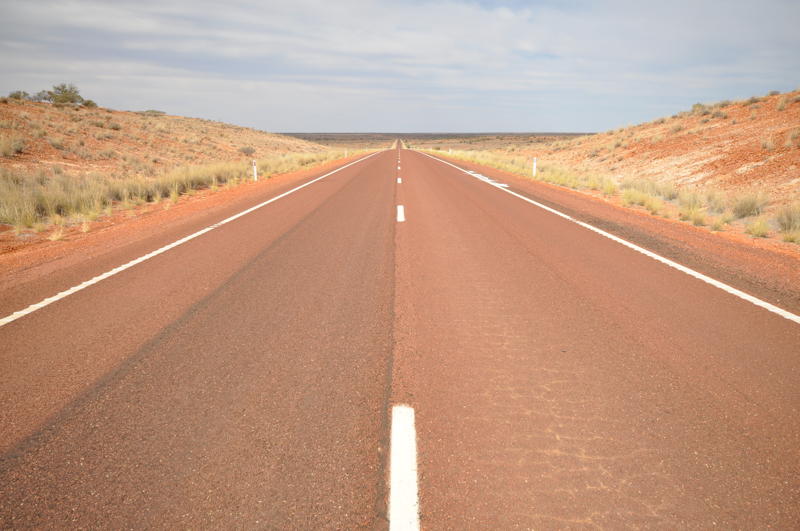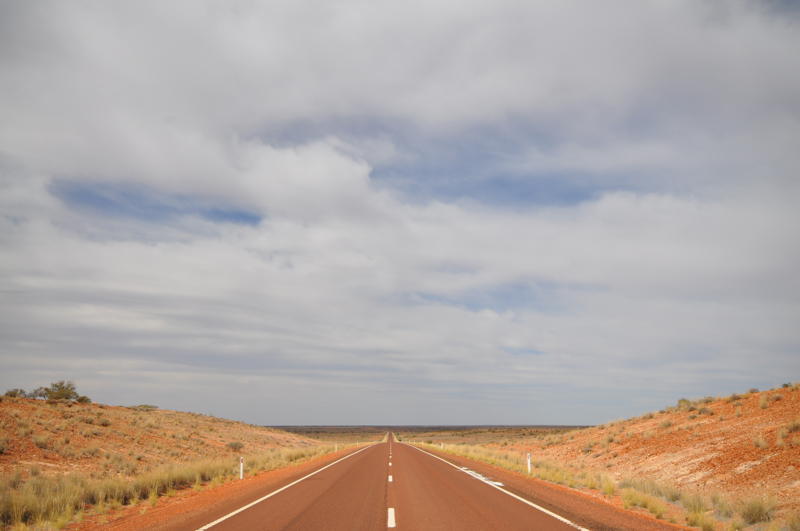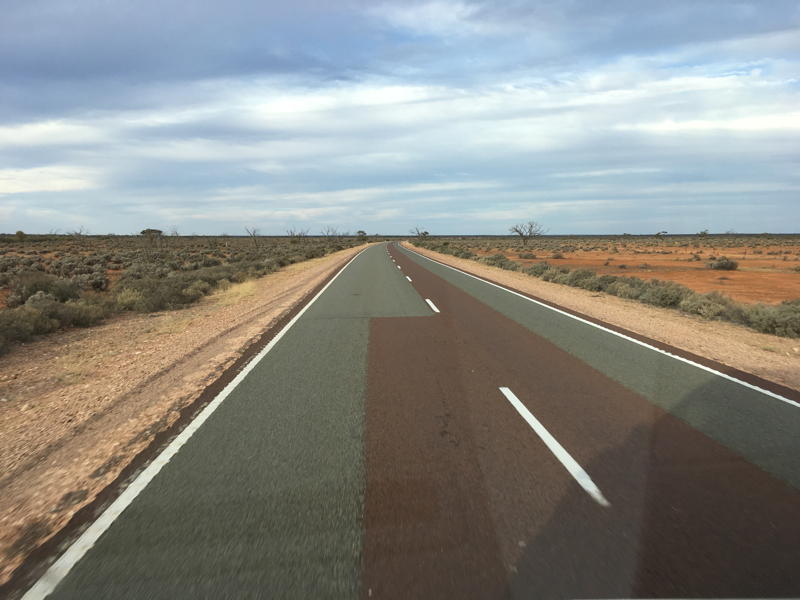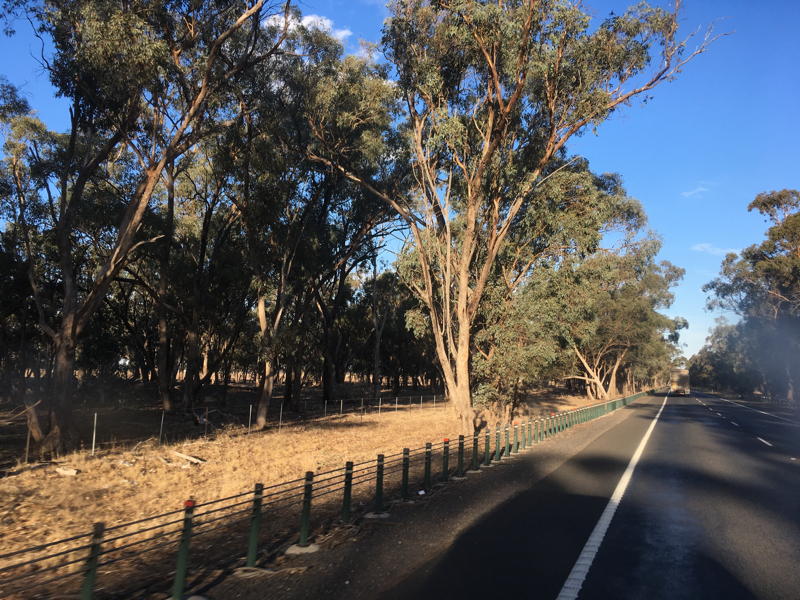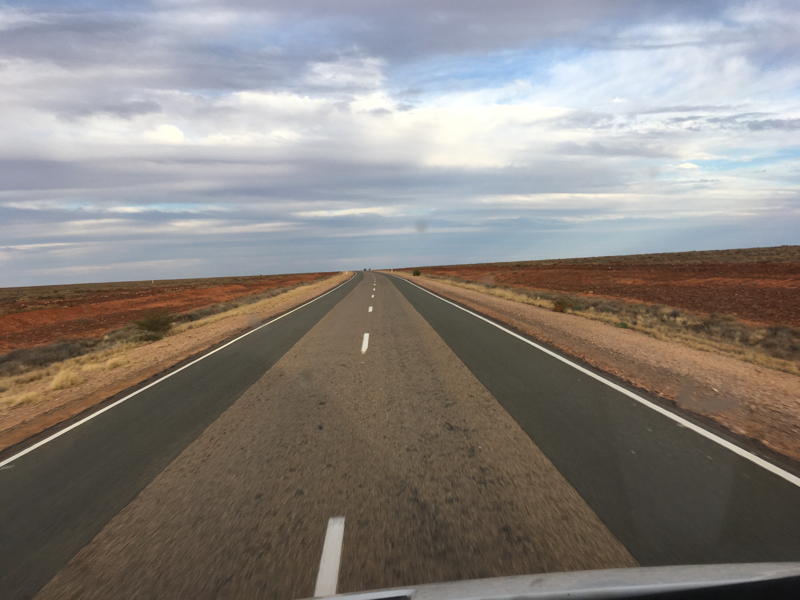The Red Centre is a vast, desolate desert, with a low human population density. The wilderness is too arid for growing crops, but in many areas sufficient to allow low intensity livestock, grazing with production is totally reliant on the natural environment. The unspoiled beauty of nature, the space, the freedom and the well-adapted wildlife are the magnets that draw my fascination. To those that intimately know the Centre, it is rich and abundant. The emptiness, remoteness and the huge distances are the charms of inland Australia. It can be harsh, forbidding and unforgiving to those who don’t respect the land.
Both Graham and I are interested in Aboriginal culture, he loves photography, I love writing. A trip to the Red Centre seems the obvious thing for us to do.
To start a journey, no matter how well you plan, as long as there’s more than yourself, delays and frustration can be expected. If there is more than one planner, the clash of ideas causes trouble. Left to one person, the other person will delay the plan, no matter what. Once this immutable fact is understood, all parties should chill out and give a bit. The organiser accommodates, the easy-going is mindful.
When a newly formed couple travel together the first time, friends often wait to see their breakup – cynical human nature. Our plan was to travel from Melbourne to The Red Centre and back by road in 3 weeks. It was a holiday for us, not the first one, but the longest one. We know each other pretty well, Graham is an outdoor person, not a fanatic, but he enjoys going bare foot in the garden, lying on the grass looking at stars. He would and he did run naked and barefoot on the midwinter sea-ice in Antarctica, jump out of an aeroplane and paraglide to the ground, enjoy skiing at the threshold of control on the ski fields. I, on the other hand, am an indoor person, I polish each grape with a brush under running water, then rinse again before consuming, have always lived in a temperature-controlled environment, avoided all school camping activities, as a child. A hair dryer and hot rollers are my daily essentials.

Travelled from Melbourne, Vic to Coonalpyn, South Australia
It was an overcast day, a little drizzle, at least not too glary when driving. Always look on the bright side, not just for travelling, but I make it a habit through life.
We were one day behind schedule. Not that it really matters, not like if we have a plane to catch. The bright side of this was we had an extra night to sleep in our own cosy bed.
Finally, we were on our way, after filling up the van with diesel and cleaning the windscreen. Graham drove.
It took more than double the expected travelling time from where I live to the Western Ring Road – M8. The traffic was held up by the “Road Blockage Industry”, the traffic control associated with road works. Shortly before the financial year end, the Road Blockage Industry is booming with local councils eager to spend surplus funds.
We stopped for lunch in Beaufort, a small, clean and friendly town, situated in a rich pastoral district, noted for its merino wool production. The commercial centre with old-style architecture blended with modern buildings. A number of historical buildings date back to the gold rush days.
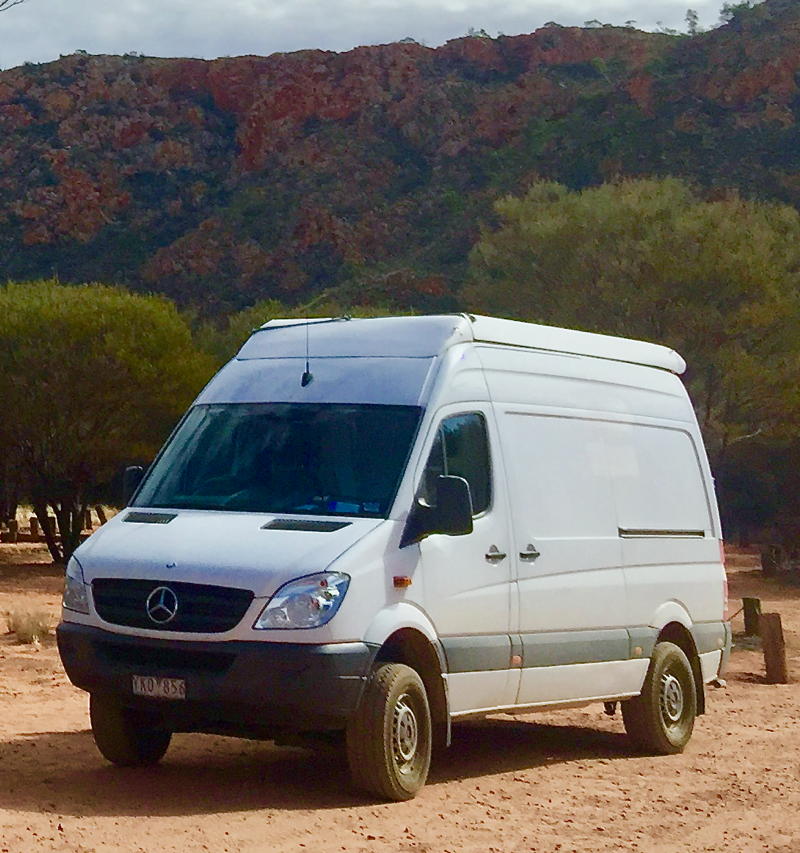
Nerd Stuff - Van Details:
Mercedes-Benz Sprinter 316CDMWBHRAWD
Length: 5.9 m, Height: 2.9 m
Weight Loaded: 3500 kG
Solar Panels: 1.1 kW when extended as awning
Electrical: 1.4 kW inverter (3 kW for a few minutes)
Battery: 300 AHrs, 12V
Water: 130 litre in tanks + 60 litre in containers (not sufficient)
Toilet: Vacuum with 25 litre tank.
Graham
A man came over to us at the park and talked to Graham, he liked his van. Graham designed the fittings inside and out, it’s a 5 star camping van with four-wheel drive. Has a shower, toilet, induction cook top, microwave oven, freezer and fridge, two really comfortable beds, solar power panels on the roof and water tanks under the van. My most loved fixtures were the fans – they kept the air circulating and fresh inside the van.
I drove after lunch – first time in Graham’s van. Haven’t touched a manual car for a long time, so it took a little while to become used to the gears again. Graham didn’t mind driving, but I didn’t think it safe for one driver to drive for too long, we should be sharing the responsibility. We pulled over every couple of hours to stretch our legs. Rushing should never be required when holidaying.
Before setting off on a long car trip, one must be sure the vehicle is in prime condition. Properly inflated tyres, all fluids at their proper levels, plus a full tank of fuel. As soon as the fuel gets as low as a quarter of a tank, fill it up if you can. You never know when the next petrol station will appear in unfamiliar areas.
We kept drink bottles, nuts and dried fruit, along with hand towels, within reach while driving. Handy for snacks on the go.
Two hours before sunset, we came to Mount Zero in the Grampians. For me it’s a challenging rock climb, but for Graham a beginner’s stroll. If you like rock climbing, outdoor exploring, wine tasting, the Grampians has an adventure waiting for you.
The paths for discovery are endless, if you can spare a few days, stay and enjoy what it has to offer before moving on. I have stayed and ventured around many times in the past, and still have tracks I wish to walk and don’t mind repeating some of the old walks either.
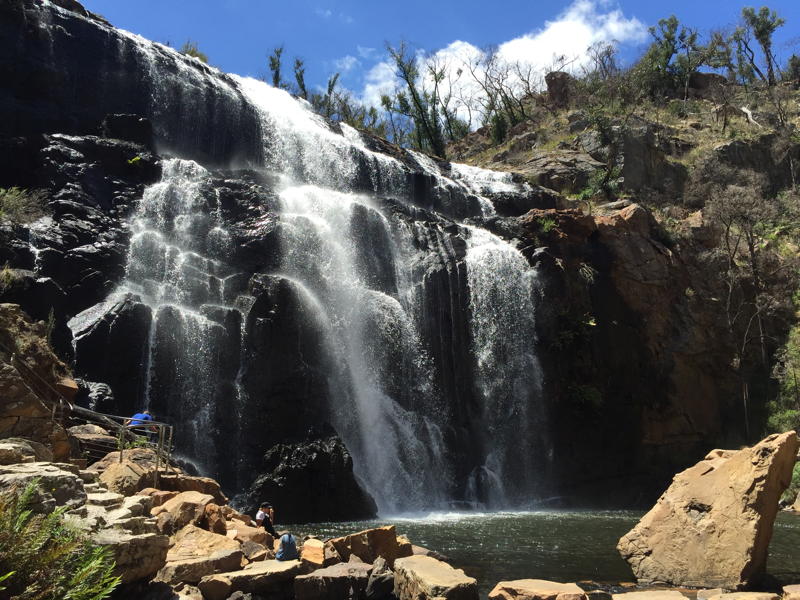
Different seasons, different companion, different mindset, can make the same paths look and feel different. Graham drove on Mount Zero’s unsealed corrugated road. The trick was to drive fast, just skimming the tops of the corrugations to give a smoother ride. Drive slowly and the road feels very bumpy. We got out of the van, did our daily walking exercise.
Road signs on the way into South Australia warn you that you must dispose of fruit and vegetables before entering the state. Restrictions apply for people bringing other plants and plant products as well. You must stop at quarantine stations to dispose of all restricted items. Quarantine inspectors can search your vehicle and confiscate restricted items. Random roadblocks are carried out on these roads, and you can be fined if you are found with restricted items.
Arrived at Bordertown, a substantial and prosperous service centre. While parked next to a creek, a man came over and talked with Graham. He was very impressed that Graham did the van’s solar roof by himself. Looks like many people in Australia would like to travel with a mobile home, especially the size of a van, as it could go almost anywhere and on almost any condition road.
South Australia’s speed limit is 110km, pretty much like Victoria. Some parts of the freeway have wire and cat’s eye fencing, separating cars and trees.
We stayed overnight near Coonalpyn, a small country town. Changed time zone – watch set half an hour earlier.
Travelled from Coonalpyn to Pimba, South Australia
We woke up for a really foggy start, visibility less than 200 meters. I started driving in the early morning, the fog lifted at 8.30 am. All drivers except one were cautious, I was so pleased to see travellers with mature minds! The one fast car didn’t cause any accident, phew! Might be a local who is accustomed to the conditions, able to drive with both eyes closed.

A road train is a long trucking vehicle, used in rural and remote areas, to efficiently transport livestock, petroleum, bulk commodities and general freight. A road train has a relatively normal tractor unit, it pulls three or four trailers. They have horizontal signs at the front and back with large black uppercase letters on a reflective yellow background reading “ROAD TRAIN”. Their restricted driving limit is 100 km, when you are stuck behind one and wish to take over one of them, keep in mind that their combined lengths could be over 50 metres (170 feet). Please take care and make sure it is safe to do so.
We stopped for breakfast at Peramanqk Rest Area, South-Eastern Freeway. The notice board warns people that “Next 7km: trucks & buses should use low gear instead of brakes”. It’s nice to see the warning before the steep descent road. Well done South Australia!
South Australia is home to award-winning wines and is known as Australia’s wine capital. Has been listed as one of the Great Wine Capitals of the World. Even if you are not a drinker, visiting a winery still seems a proper thing to do! Graham and I both have done that many times prior, this trip we were focussed on the Red Centre and trying to immerse ourselves in nature on the way. Graham is a bush walker, camping is always part of his activities. I am a big city person, love all modern day luxuries. He was trying to introduce something new to me, to extend our passion for rock n roll dancing. I am adventurous, willing to try anything within reason, as long as I don’t have to compromise my health nor physical comfort.
Driving around Adelaide, looking at all the places that Graham remembers as a young teen, walking around his old neighbourhood, hearing bygone stories were inspiring for me.
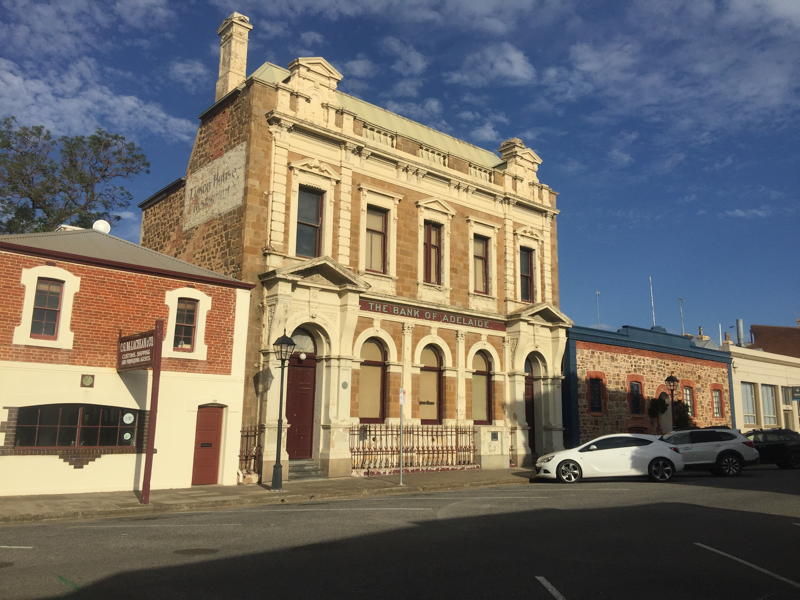
Graham was particularly interested in seeing how the old Bank of Adelaide in Port Adelaide was surviving modern times. He hit lived on the top floor of the 150 year old building as a child.
After buying some fruit in Port Adelaide, we were ready to move again.
On the A1, around Port Wakefield, we hit a traffic jam. Cars were moving very slowly, couldn’t see any reason for it. About 15 minutes later, around 1.40 pm, the weather became windy and the air laden with dust. The 60 to 90 kph gusty winds were shaking the van. I held the steering wheel firmly with both hands, while trying to relax my arms so they won’t fatigue too much. The blustery wind was making me very aware that anything could blow into my path and I would have less control and less time to react if I was driving too fast. As far as my eyes could see, dust had had its way with the wind, all the vehicles on the road – small or big, short or long, were all humbled, none dared to challenge nature. Travelling slowly and carefully, all we could hear was the howling wind – it totally masked the engine noise. The dust eased after a couple of hours, but the strong wind continued into the night.
The situation was something you wish did not happen to you, but once you safely pass through it, you are certainly glad of the experience.
While driving in the dust storm, I tried to give other vehicles a lot of space on the road. Regardless of weather, we should be giving large trucks, especially road trains, plenty of space. I always give way to working vehicles, like trucks, tradesmen’s vans, taxis, etc. They are the workforce making a living, we were in no hurry, so why not be more thoughtful?
After we both had had enough of the wind, we stopped about 20km short of Pimba for the night. As we stepped out of the van, the wind threw prickly bits of desert plants at us, irritating any exposed skin, so we quickly got back into the van. The wind didn’t quieten down, tirelessly shaking the van throughout the night. It provided a soothing sleep, like a gently rocking cradle. The sound of the howling wind became lullaby music for exhausted bodies.
Travelled from Pimba to Coober Pedy, South Australia
We woke up to a peaceful dawn, the wind had stopped, leaving a thin film of red dust inside the van. Graham said “Don’t worry, its clean dirt”. He was right, I was holidaying, if the dirt was clean, it would suit me to a T. Without being pedantic, I had the chance to look at our campsite in the beautiful colour of sunrise. We were surrounded by semi-desert short grass and plants, in the distance lay a white coloured salt-lake. Without a word, we happily put on our hiking boots and went for a morning walk towards the lake.
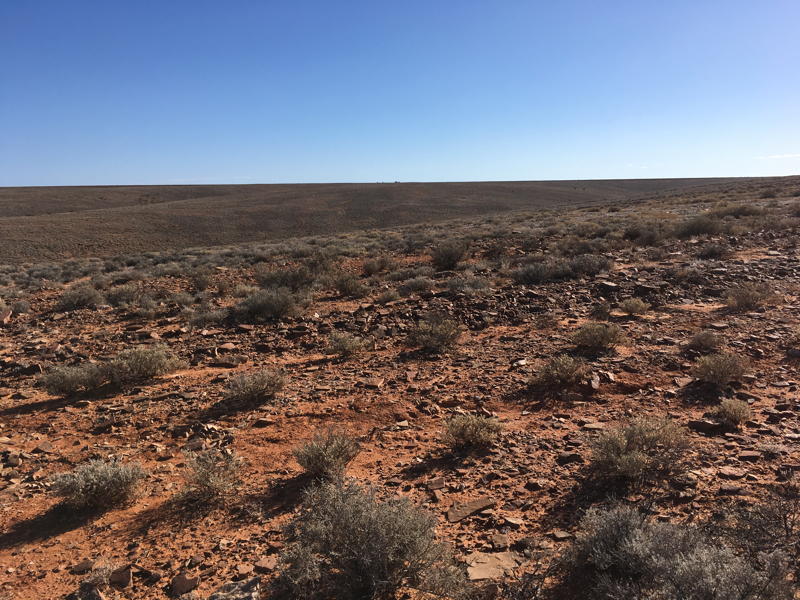
Had our first encounter with the natives, although we were carefully not making any noise, they still went hopping away, not wanting to know us. Fair enough, after all none of us have a strong tail like them, if I were them, I wouldn’t want to know animals like us either. The ground was covered with small gibber stones and without a walking trail was hard to traverse. We didn’t reach the salt lake. The temperature was getting too warm, so half way we returned via a different route. The 1½ hour walk didn’t seem that long, especially with the featureless but nonetheless interesting landscape.
The bitumen road leading to Coober Pedy was colourful – red, grey and green coloured; obviously sourced from local materials.
Some parts of the road had all the colours mixed and matched. On other sections of the road, opposing lanes were in one colour and the dividing centre in a different colour. It was the most beautiful bitumen road I’ve ever seen. It looked even better when I put on my sunglasses, the colours became deeper and more contrasted. Some road patch-works used different colours of bitumen, looked quite artistic, good enough to extract and hang on some gallery wall; they might be more attractive than some art pieces.
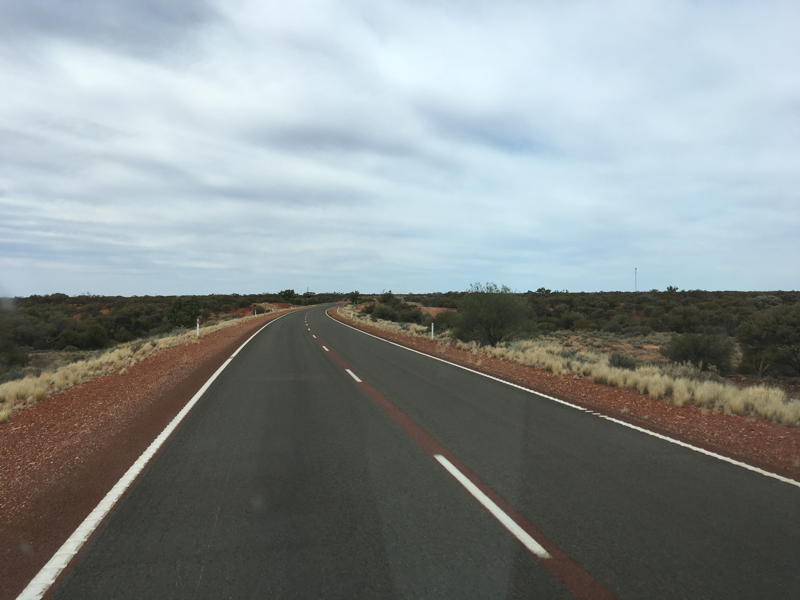
Most of the roadsides were covered with red soil, dotted with short dwarf trees, green or silver coloured vegetation and resurrection grass. Lots of burned black tree trunks. Eating colourful fruits and vegetables is good for our physical health; I feel staying in these subtlety coloured surroundings must be good for one’s mental health.
It was a sunny day, the beautiful blue sky supporting little white clouds close to the horizon. Drove for hours, landscape and horizon didn’t change at all. We were enjoying the vast space that no city could ever supply.
Some animals unfortunately had been killed by vehicles, it was not a good feeling to see the twisted bodies of animals lying on the road. If a kangaroo is hit by a car, it might have a little joey in the pouch, if the car didn’t kill them both at the same time, the joey would die later without a mother’s feeding and protection. The roadside animals’ bodies we saw included snakes, feral cats, kangaroos, cattle, boars, goats, eagles and many other kinds of birds. Today’s road kill count was 60. Judging by the look of the carcasses some were killed before today, but many not that long ago.
To escape the intense daytime heat, most animals living in the Central Australian bush forage at night. Best practice is to avoid driving at night to minimise the risk of road kill and vehicle damage. The animals are part of our ecosystem, they have the right to live just like us.
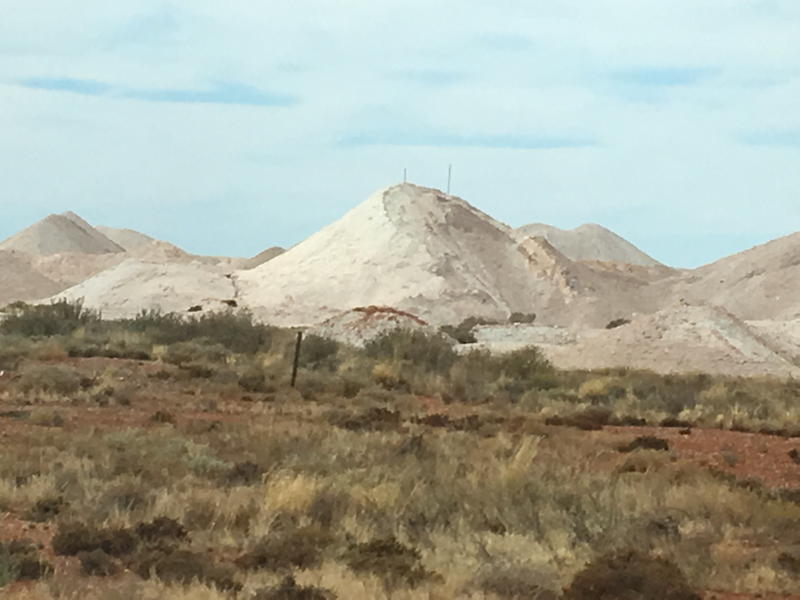
We could see lots of mainly white tailing mounds, starting from 50 to 60 kilometres before Coober Pedy. There are more than 250,000 mine shaft entrances because of laws regulating large-scale mining of opals, so speculators worked around the law by opening multiple entrances. The town is world renowned for its original opal mine, and for its unique underground living to escape the blistering summertime temperatures. Years ago, I came here to simply experience the underground living – it’s like anything else, if you are interested to know what it’s like, try it.
Graham had travelled to Coober Pedy less than two years earlier so had a vague idea of the layout. We drove around and had a good look at this raw and temporary place in more than 35°C dry heat – and appreciated the van’s air-conditioning.
Travelled from Coober Pedy, S.A. to Alice Springs, N.T.
The campsite where we spent the night wasn’t too far from Coober Pedy – it was just a rest point, 100 meters off the main road. We spent 90 minutes walking around after breakfast. The ground was a rich red, with lots of hematite nodules spread over some parts of the ground. These were fascinating because of their glazed appearance and density due to their iron content. We could see the evidence of wind patterns, animal footprints, reptile tracks, ant colonies, but we could not find any trace of other people ever walking on that ground. It reminds me of a story I once read, a man was drifting on the river with a tiny boat, came to a beautiful village. He spent some time with the people there and fell in love with that place. After he returned home, he couldn’t forget the breathtaking scenery and good-natured people, so he tried to return. Somehow, he could never find it again.
It was a nice place to camp at night, a great place to walk in the morning. Utopia? I didn’t think so.
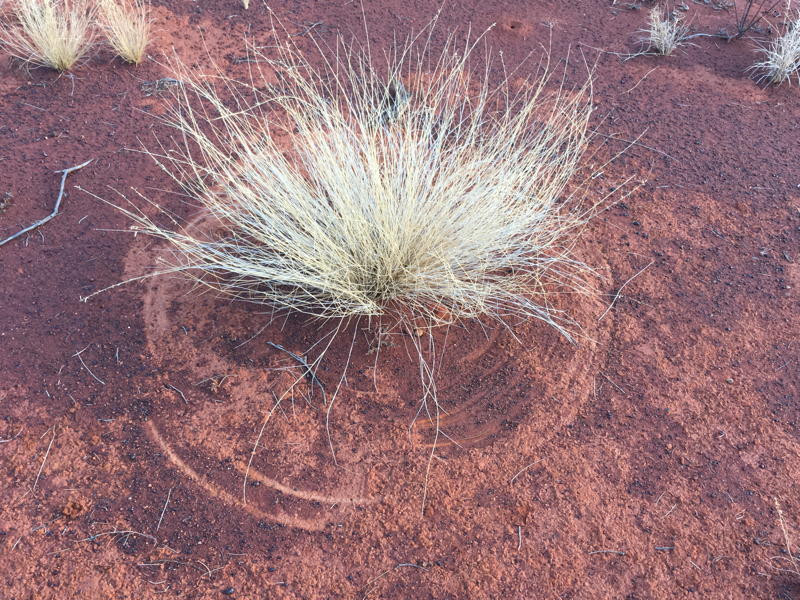
Many of the campsites we had stayed in the past few days were rest points for weary drivers, not official camping grounds and often without toilet facilities. A downside of this is they often had toilet paper and other tissues flying around in the wind, laying around the surrounding area or snagged on the short bush grass. Not really kind to nature, nor visitors. Disgusting in fact. I really wish folks would bury their “business” properly when caught short!! All should carry a shovel to dig a (deep) hole if without a “portaloo”.
At 1.35 pm we crossed the Northern Territory border. A 130 km speed limit. Only 270 km to Alice Springs. It was 35°C, again.
Up until now, no river nor creek bed had any water. But we did witness evidence of recent showers – damp soil and new shoots. I imagine the first 10-30 mm of rain just soaks in without flowing to the watercourses.
Four hours later we arrived at Alice Springs, popularly known as “Alice” (or “The Alice”). It is roughly situated in Australia’s geographic centre, between the East and West MacDonald Ranges.
Alice had lots of flies, in fact everywhere in the Red Centre had a lot of flies, but there seemed to be more in Alice. They fly straight to the corner of your eyes, into your nostrils, enter your ears, crawl into your hair, land on your food, swim in your drinks. Anywhere you don’t want them to be, guarantee they would be there. You could not talk, they would fly into your mouth as soon as you open it. The mosquito nets we bought to put over our hats and extending to the shoulders were our best purchases ($8 each. for the up-market model) on our trip. A fly-swat in the van was also much used and preferred over fly-spray. If the timing suits you, wait till the winter, when the temperature drops below 10°C at night, greatly reducing the fly population.
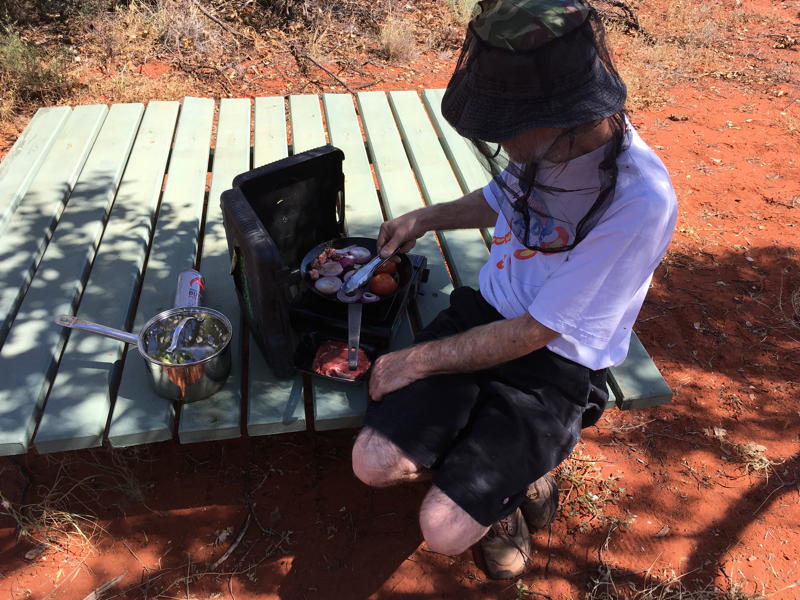
With hat and fly-net, preparing a meal. The simple table/seat design is a Northern Territory innovation.
Be aware Alice has severe alcohol restrictions, it’s one of those things that you really need to understand before you visit. You will be required to provide a driver’s licence to purchase take away alcohol. Outdoor drinking in public is banned.
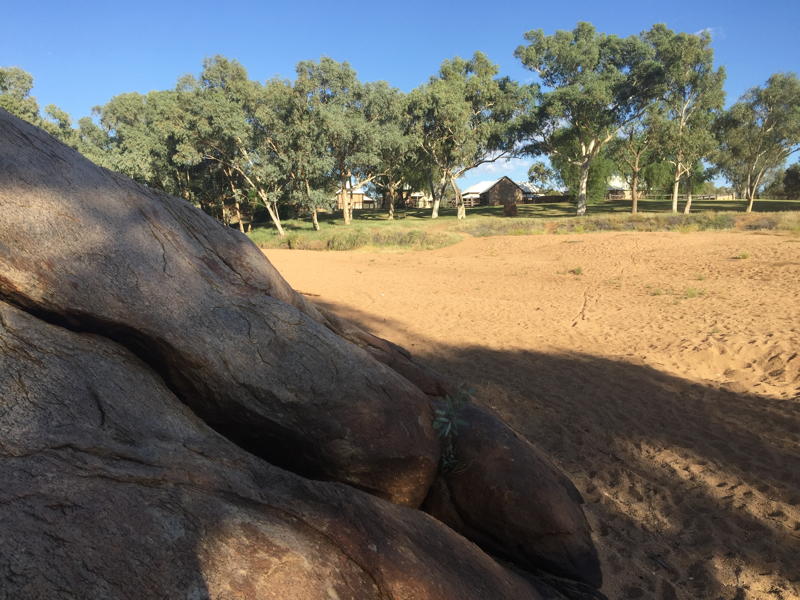
We stayed away from the Alice centre, near the old telegraph station, had a quiet and peaceful night.
This region is very dry, receiving on average just 150 mm (6 in) of rainfall annually. A massive Christmas night storm and heavy rain sparked damaging flash floods in Central Australia in 2016, recorded 62 mm in just one hour. Was described as a once-in-a-half-century weather event by the Bureau of Meteorology. So, whenever or wherever camping in the region, don’t camp in dry creek beds – people have drowned.
Travelled from Alice Spring to Chambers Pillar, N.T.
Woke up in the morning, breathed in the bush land’s fresh air. Graham and I both yearned to settle in Alice at that moment. The air was fresh and cool, flies had not mobilised, everywhere we looked was connected with nature. No traffic, no pollution, no man-made noise, what an amazing state we were in.
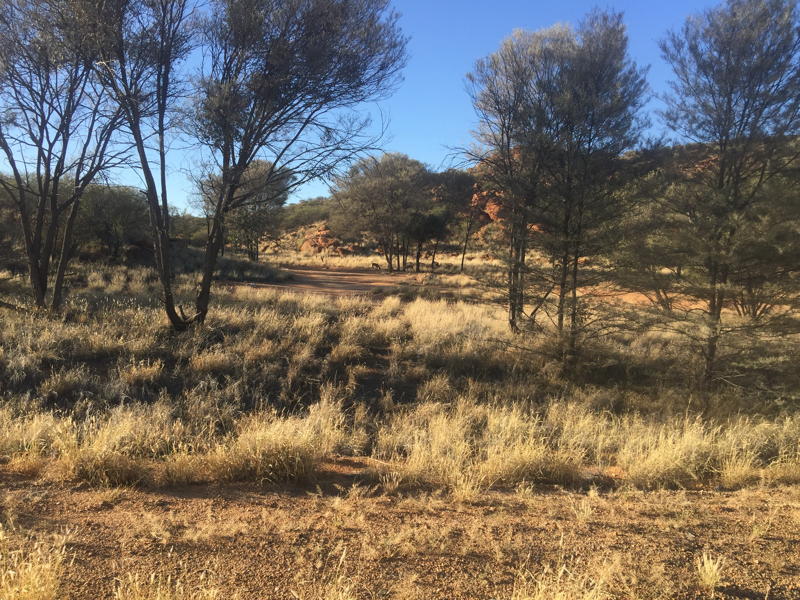
We put on our hiking jackets and went for a walk in the nearby park. We felt optimistic and a sense of pleasure, leaving mechanical routines behind. Life is good when you are feeling good. It was the first time since we left home that we saw other people walking or cycling while we were walking, simply because it was the first time we were walking in a reserved park. A couple of hours later, the temperature had risen, the flies were flying and the stunning blue sky had filled with puffy white clouds.
Alice is a remote town of about 25,000 people. It doesn’t have the spread of some of the suburbs in the big cities, nor the number of rude people behaving like they had rights over well-mannered citizens. Alice had a much more relaxed atmosphere, no one seems in a hurry, everyone takes things as they come. I did not see any face with aggression or frustration – maybe the heat melted everyone down.
After leaving Melbourne, we shopped at Woolies a few times. Not one staff on the checkout knew how to do an E-giftcard payment. They are all very friendly though. Also, once out of Victoria, no shopping place provided disposable plastic carry bags. Shops do sell bags, 15c for single-use ones, 99c for reusable ones. (Two months later, Victoria has adopted the same system.)
Before lunch, we headed to Chambers Pillar, a sandstone formation some 160km south of Alice. The road is unsealed and when cars pass on the opposite side of the road, had to slow down because visibility was so bad due to dust trails.
Stopped at Napwerte Conservation Reserve to look at Aboriginal stone carvings. It was 35°C, I used an umbrella, for that little extra shade, every bit counts. Didn’t want to miss the historical site simply because of unbearable heat.
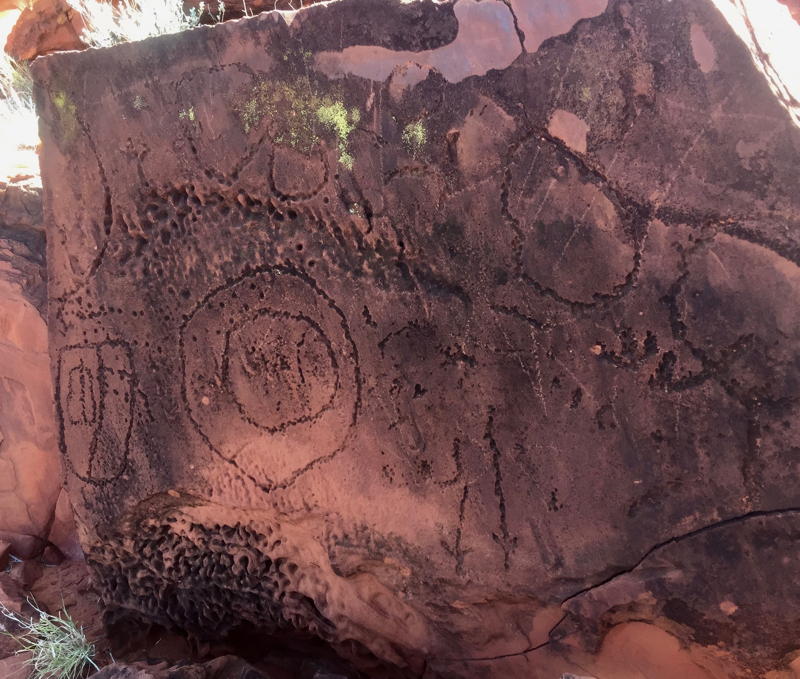
On the way we saw four or five hundred Hereford like cattle crossing the road, with a helicopter circling at low altitude to keep an eye on stragglers. Three men on motorbikes and a fourth opening and closing the gates – modern day jackaroos. I was disappointed when we could drive on again, I was totally fascinated by the whole operation, wouldn’t have minded if we were delayed for longer.
Graham drove the whole day, I didn’t mind being “Lady Muck”. Who would know it turned out that I needed to get out, into the heat, opening and shutting the gates on the way many times, so I ditched the “Lady Muck” title to become officially a jillaroo – you don’t have to tell me “In your dreams”, I know! Who in the right mind would give a city girl like me the job of jillaroo? Nonetheless I was pretty proud of that title for a while.
About two-thirds of the way to Chambers Pillar, the last hour of the road had deeply corrugated surfaces. Graham changed the van to 4-wheel-drive, to negotiate some deep sand drifts, steep jump ups and rolling sandy hills. We took 25 minutes to drive over 16 dunes that stretched about 11km. Take note, this road may be closed after rain, so take note of any signage indicating road conditions. Also watch out when driving over the dunes – oncoming traffic can’t be seen until the last moment. I felt uneasy at the time, but Graham thought it was fun, did we really travel together on the same road?
After we arrived at Chambers Pillar, we walked for an hour before settling for the night. Without the sun shining on us, 30°C was acceptable for walking and we watched the sunset.
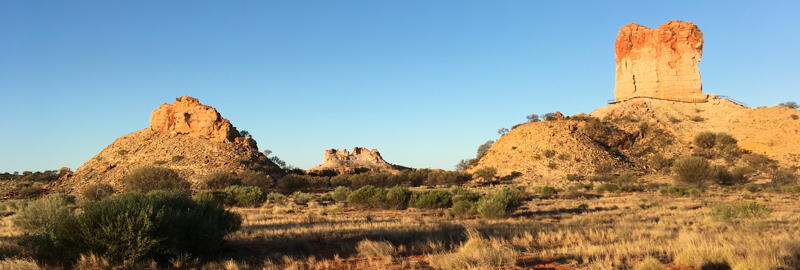
Most formal campsites in the NT parks work on an honesty box system, charging $3.30 per person per night. There were 2 families with young children and a few couples camping at the same ground as us, no one was out of place. The night wasn’t totally silent like the previous few nights, but it was quite nice to be part of a temporary community at that moment.
There’s nothing like the Australian outback sky, far away from the busy city lights, the stars seem brighter and clearer. The Milky Way displayed above our heads and an iPhone app helped us find the Hunter, Hare, Unicorn … we wished the night would never end. Where else could you see the universe with naked eyes as in The Red Centre? Saw a few shooting stars – we were hoping a predicted meteorite shower would show earlier than expected, but it didn’t. The Southern Cross took over our attention. The thought that the nearby dark area was the centre of our galaxy and it’s black-hole fired the imagination.
Returned from Chambers Pillar back to Alice Springs
We woke before sunrise, wore 3 layers of clothing, spent 1½ hours walking on the tracks. The spectacular solitary column towered 40 metres above the Simpson Desert plain. Pity to see people had carved their names on it, graffiti is not welcome in cities, worse to see in nature. Why can’t we hand the world to our future generations in the way that nature intended?
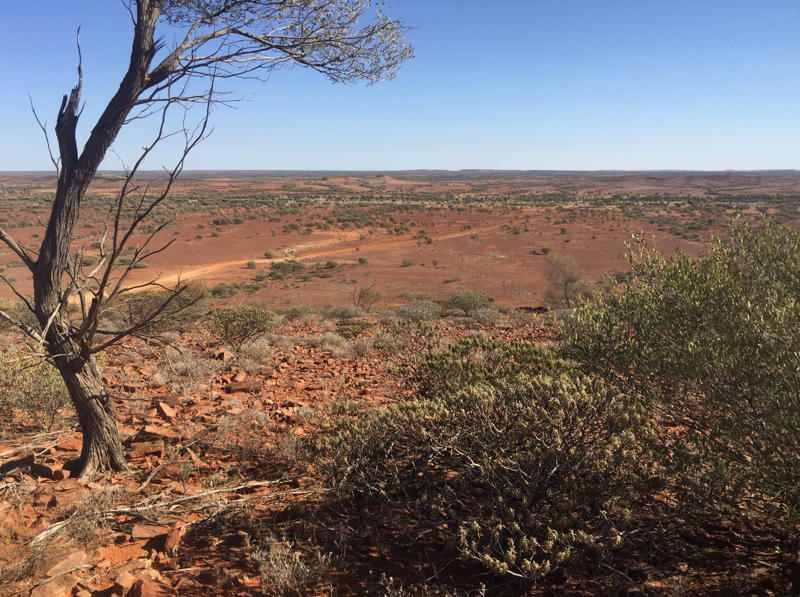
On the way back to Alice Springs, saw 8 feral donkeys, all looked very healthy. They have been declared a pest, owing to the damage they cause to vegetation and soil.
There was a racing track next to the Stuart Highway, two motorbikes were racing, a 4WD car was on the Highway following them. On the way, saw old tyres, tyre rings and empty drinking bottles hanging on the tree branches – another form of modern art?
We stopped in front of an outstation property, looked at ruins of a water tank and windmill. A well-spoken gentleman stopped his car and talked to us, answered a few curious questions we had.
He reminded me of an old friend of mine, they both had that calm confidence, humour, lucidity and sense of trustworthiness; one was the son of a well-to-do English family, this one was an Aboriginal man from the land. That’s the beauty of Australia, we are a mixing bowl of multicultural backgrounds, this is an interesting land on which to live.
Saw a willy-willy, swirled all the way from the road to the sky, about 50 metres high, right in front of us. A willy-willy’s a strong, well-formed and relatively long-lived whirlwind mixed with dust and dirt. Similar to tornados, but smaller both in size and strength. They are called dust devils in America.
Dropped into Rainbow Valley, it had scenic sandstone bluffs and cliffs that were impressive to look at, the formation was delightfully carved by wind and rain over millions of years. We spent almost 3½ hours walking in 30°C plus heat, there was so much to see, didn’t realise time past so quickly. Drinking plenty of water was crucial.
Arrived in Alice close to dusk. Stayed near the old telegraph station in Alice again.
Travelled from Alice Springs to East MacDonnell Ranges
Saw two dingoes this morning at the campsite, they were both ginger in colour with white feet, walking side by side, marking their territory on the tree trunks. Completed the picture of the nature of the Red Centre.
One thing I liked very much in this trip was sleeping amongst the desert bush, feeling the tranquil, undisturbed, relaxed setting, what a wonderful nature, what a wonderful world. My very first trip to the Red Centre involved flying from Melbourne, staying in hotels and visiting the iconic sites by tour bus. That’s a good way to travel if you are short of time or lack a sense of adventure. But with driving and camping, one has the chance to be part of the landscape, taking our senses back to pre-modern times. If you love nature, wish to be part of it, this would have to be the best way to travel in Australia.
On the way to the East MacDonnell Ranges, some parts of the road had bitumen, most parts were dirt. Some parts only had a single lane of bitumen, so when encountering a car coming in the opposite direction, both cars needed to partially drive off the bitumen, right wheels on the bitumen, left wheels in the dirt.
Once three black (an uncommon colour in the Centre) cars in a convoy approached us. They didn’t intend to move from the centre at all, as if they had the right, quite rude. I rather think they were foreigners and didn’t know better. Australians by and large were considerate on the road – we love our country and usually show courtesy towards fellow travellers.
The magnificent Emily and Jessie Gaps were both creek-worn gullies. In the Corroboree Rock Conservation Reserve, the rock itself is an outcrop of dolomite from the Bitter Springs Formation originally laid down in salty lakes 800 million years ago. Dolomite is a soft sedimentary fine-grained rock.
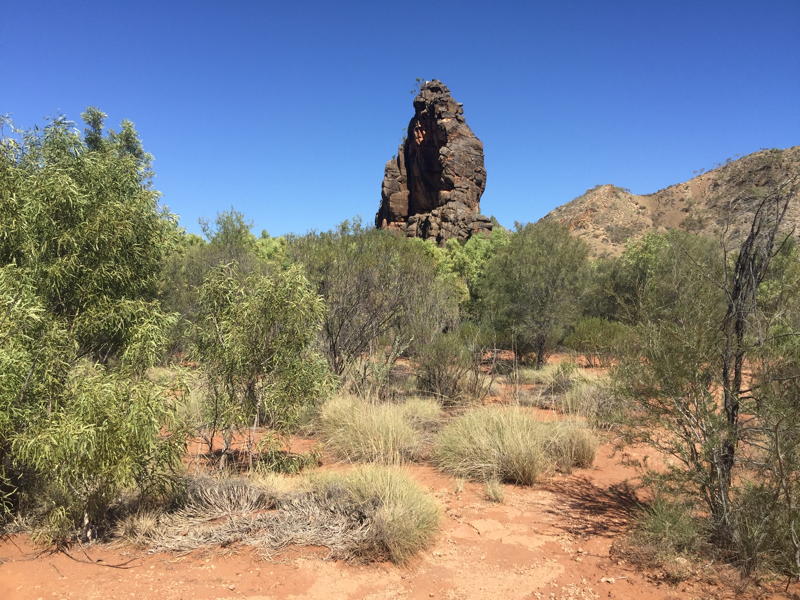
Followed the main access road from the Ross Highway through to Trephina.
In the Gorge Nature Park, the rugged landscape is the home of the largest Ghost Gum in the country, therefore in the universe! It was the best looking specimen I have ever seen, looking majestic and healthy. It was 33 metres tall, estimated to be over 300 years old, but pretty young compared to the surrounding rocks.
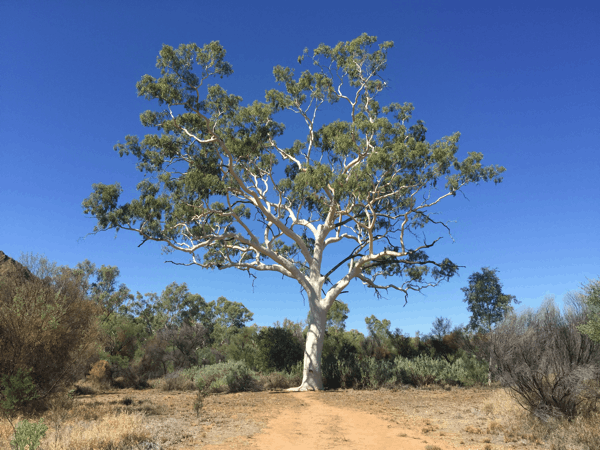
From there to the John Hayes Rockhole, the last 5km was a pretty rough track. Seated in the van, felt like being in the cradle again, this time had a drunk or bad-tempered parent to rock the cradle, last time in the windy night, the parent was much calmer than today’s. The last 4 km took 25 minutes to negotiate. The middle of the narrow track had formed the Great Wall of China. Indeed, needed the high clearance 4WD of the van to deal with all the humps and bumps. I imagine the road would be impossible to drive on after heavy rain. Towards the end was a dry river bed crossing with large stones. I thought maybe we should turn around and go back and forget about this very unwelcoming attraction.
Finally, we arrived at the John Hayes Rockhole. We took an easy walking track and within a few minutes I stopped at the first Rockhole. It was too hot for me to keep going so I sat in the shade by a rock pool. Heat didn’t bother Graham at all, he walked along the narrow rock ledge next to the rock walls, happily exploring the waterholes further. He said the other two holes had clearer water than the first. The second hole was half the size of the first and the third was 1½ times the first. There might be a fourth one, but I wouldn’t agree with Graham leaving my sight, so he couldn’t continue, although he would have loved too.
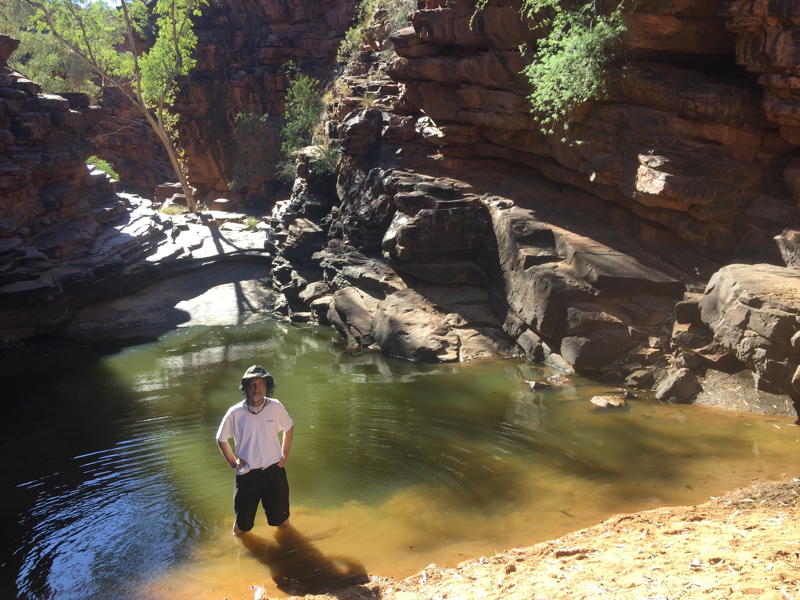
Graham said it was worth all the hard driving. The water in the hole was very cold and refreshing, he dipped his feet in and sat there for 20 minutes and absorbed all round him. The surrounding rocks had a glazed finish that added interest and mystery. He said the mind and body felt so good, he simply loved the whole experience.
The Northern Territory National Parks had the best toilet design in the bush! It uses a simple passive solar vertical vent pipe system over a concrete drop pit. Everywhere we went so far had toilet paper. The toilets were not smelly, although there’s no water to wash hands, nor was water needed to flush. Looks like people respected the system and did the right things to keep the place clean and functional.
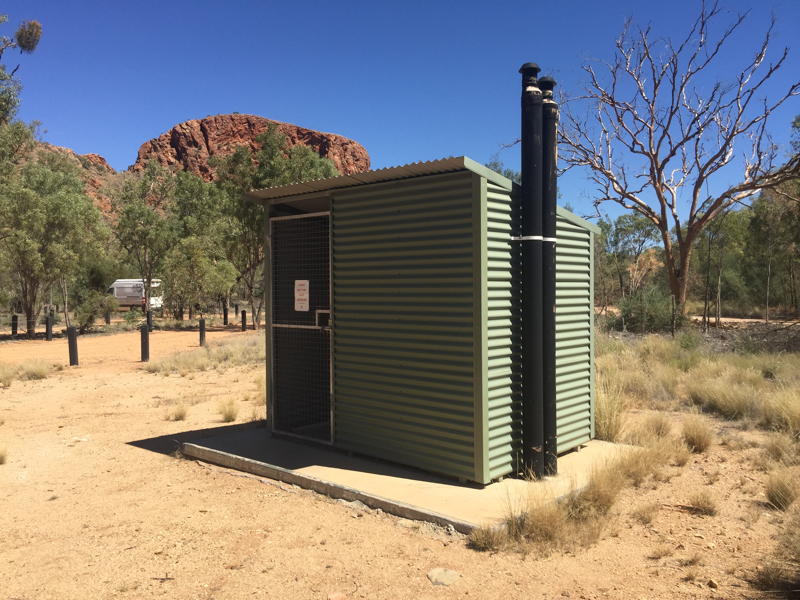
We camped at the Trephina Gorge campground. Not many campsites have water, this place had taps everywhere! I washed my hair under one of them, and because the weather was so hot, the cold water felt wonderful, much better than washing in the van. While I was washing, no flies bothered me, but as soon as I rinsed clean, they all swarmed back. Well, I wonder what this phenomenon said about the shampoo? (I minimised the amount of shampoo I used out of concern for localised pollution.) Boy, the head-net was so good, to keep the flies away from my head.
We didn’t want to walk under the blistering sun, so we stayed in the campsite, catching up with reading and writing, although there was no internet connection.
In the evening, we took a one-hour moderate rated walking track. Once we reached the top, we followed the edge of the hill. Certainly overwhelmed by the depth of the geological time frame before us. We could see clearly the difference of days, weeks, months, seasons, years, generations in the cities. Right there, in the middle of the Red Centre, time seems to have stopped, or I shall say time means nothing at all. It was already hundreds of millions of years old, pre-humans hadn’t appeared on the earth yet. No wonder the Indigenous folks here have no word for time; what’s 100 years to the place? Not to mention that most of us don’t even have that much time.
After dinner, we lay on a bench to watch the sky. It was magical away from light pollution. No moon tonight so the stars shone brightly against a jet black background and far more were visible. We found and viewed a group of planets together, to locate our favourite stars and constellations. Would love to stay in the open the whole night, sleep under the sky, if I were not worried about dingoes.
Other campers had fires going. Other than for cooking, they also served as insect and predator deterrents.
Around East MacDonnell Ranges
An easy day again. Walking 1 hour before breakfast, we picked an easy walking track on the river bed, it was sandy all the way.
Did some washing, hung it on the stainless steel fence to dry. Water was wonderful here – cold, refreshing, sweet and untainted. This campsite was so nicely planned, free gas BBQ stoves, above ground fire places, undercover seating area, open off ground picnic benches – we lay on one to watch the sky and did some plank exercises. All we had to pay was $3.30 per person per night. People staying there respected the place and were well behaved.
The MacDonnell Ranges stretch over 640 kilometres running east-west through Alice Springs, these vast and spectacular ranges are an outstanding example of an ancient landscape sculptured over time by climatic and tectonic forces.
Travelled around West MacDonnell Ranges.
Had our morning walk before heading to Simpson’s Gap, it’s the easiest site to access.
Drove into the car park, first impression was a clean place, had all kinds of rubbish bins lined up next to the car park for visitors’ convenience. The breathtaking country we had travelled through didn’t provide disposal services for our modern waste, so we happily gave those bins a good feed.
An elderly man who ignored the “No Climbing” sign made a big splashing pose on top of a large rock, his companion watched on with a hard to read expression, not sure whether she was proud or ashamed.
Not that far away was Standley Chasm, the deep red cleft crowded on either side by craggy slopes that rise 80 metres above the floor. The sheer quartzite walls glow from reflected sunlight to create a brilliant display of stark form and rich colour. This is the only privately-owned gorge in the West MacDonnell Ranges. There is an entry fee to cover the maintenance.
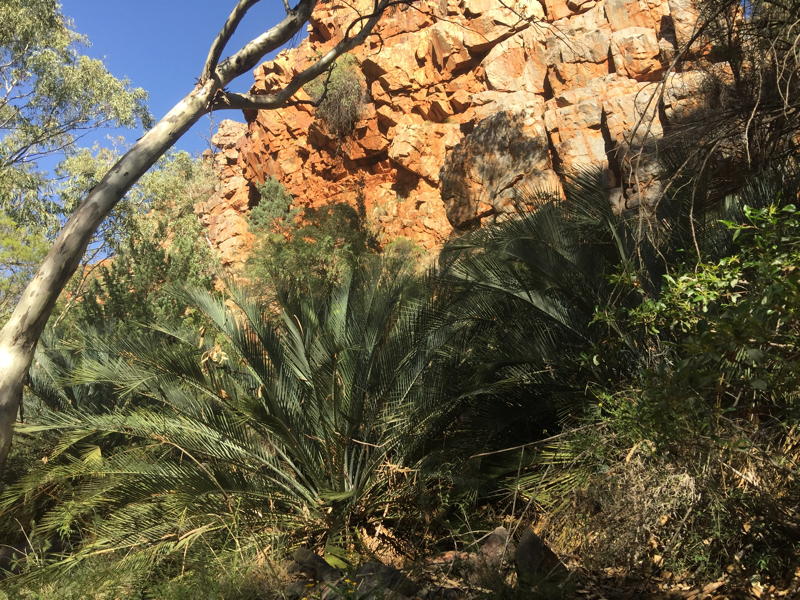
A very nice Aboriginal young man served us at the kiosk café when we were paying the entrance fee. He spoke nicely, looked like he came from a good quality family, good appearance and mannerisms. It just proved once more, no matter where you come from, it’s the standard that counts, not the colour of the skin. Racism is simply ignorance. The young man pointed out to us a few attractions that we shouldn’t miss, we spent an hour watching, searching and looking on a 20 minute walking track.
Serpentine Gorge is 100 km from Alice. A lookout above the cliffs gives hikers a good view of the winding narrow gorge and series of waterholes. Walking at 33°C was too harsh for me.
Ormiston Gorge is 135 km west from Alice, had an interesting variety of native fauna and flora, some relict plant species remaining from a tropical past. The Gorge had a near-permanent waterhole, many people were swimming, Graham had his share too. He said the cold water was most refreshing and the swim was good exercise too. I sat on a rock and worked on my laptop. Nearby was a campsite with flushing toilet and shower facilities, but we didn’t stay because it was already heavily occupied with caravans and tents almost to capacity. We are city folks, craving space on our holiday, we’ll have our crowded environment when we get back to the big city.
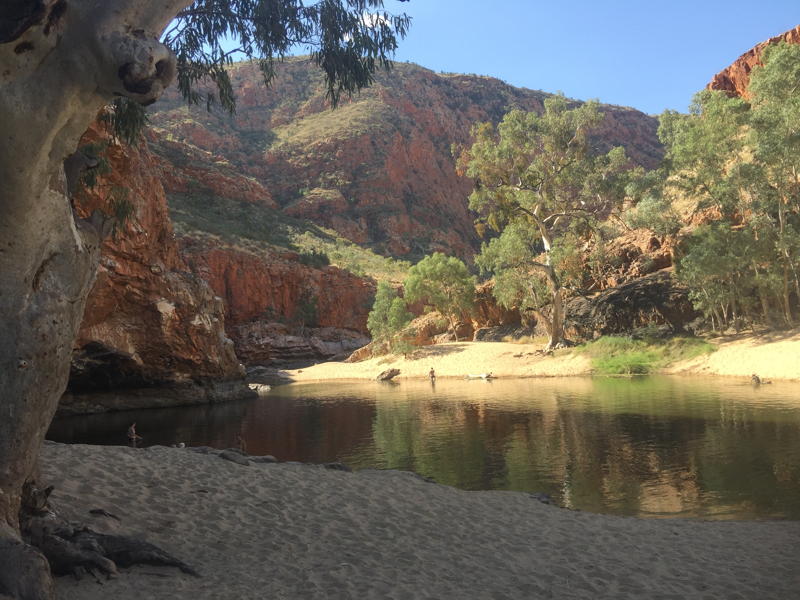
We wanted to go to Kings Canyon, so we had to get an “access road permit” from Glen Helen first. It cost $6 to get the permit, quick and easy in 32°C heat. The fuel price was $1.71 per litre compared with Alice Springs at $1.53, not that much different considering the distance between them.
Saw a road sign “Winding road next 8 km”, we both were looking forward to the change in the road. After driving on a straight road for a long while, any change would be good for travellers. Who knew that the next 5 km only had about 3 or 4 bends in the road. After 5 km we saw another road sign “Winding road next 3 km”. This time the road had about 6 bends, they were all easy bends, no need to slow down. Many kilometres later, there was a road sign “80 kpm”, followed by lots of winding turns. Why no winding road warnings when needed? I was puzzled, Graham just loved the NT’s sense of humour.
A few days ago, when there was a road sign “Narrow road”, it turned out to be a wider road. That was the first time Graham said he loved the NT’s sense of signage humour.
Saw at least seven abandoned cars on the roadside, all damaged. Some clearly had the windscreen smashed; looked like they had collided with large animals, followed by driver panic and subsequent loss of control. Damaged cars can be replaced with new ones, but nothing can replace a lost life – human or animal. All lives are precious, one life lost causes a whole family’s grief, some will never recover from their loss.
Came to Tyler Pass, a place to stop for spectacular views of Tnorala / Gosse Bluff, a crater created by a 600 meter comet crashing to earth 142 million years ago. The original crater is believed to have been about 20 km across, but erosion has removed the outer rim, leaving only the hardened centre, a 5 km diameter uplifted area that looked like a crater in its own right.
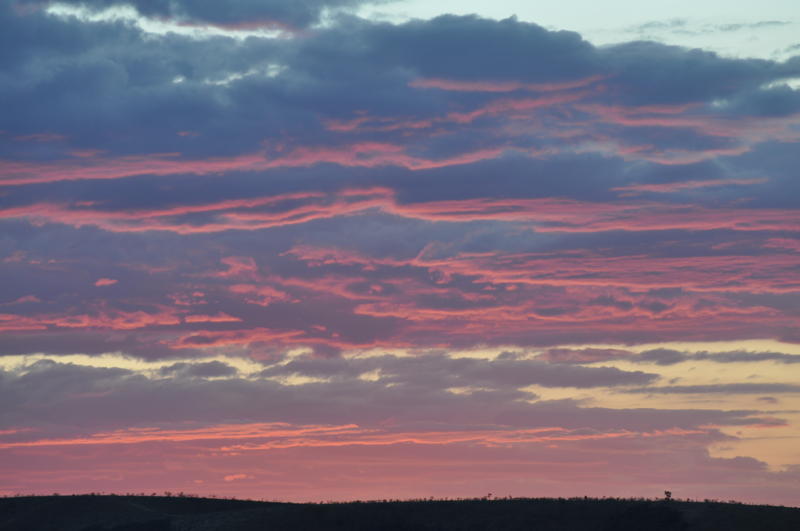
Travelled from Tyler Pass to Kings Canyon via Gosse Bluff
After Graham took lots of photos of a wonderful sunrise, we headed for a meteorite crater. The road was rough, some parts were in bad condition, the surroundings were rugged.
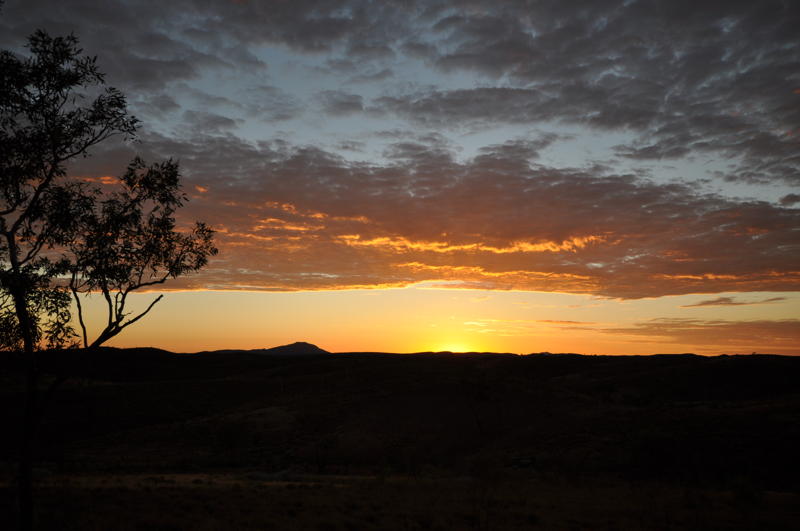
Gosse Bluff: nicely set up for picnics, had bush toilet, but camping was not allowed. First thing we saw when we drove into the park was a snake, probably a tiger, crossing the track in front of our van. It was on a determined route to somewhere. That was its home, we were trespassing, so I was cautious and showed my respect.
We stopped for photos, trying to capture the images in our mind of such a catastrophic meteorite impact, before moving on.
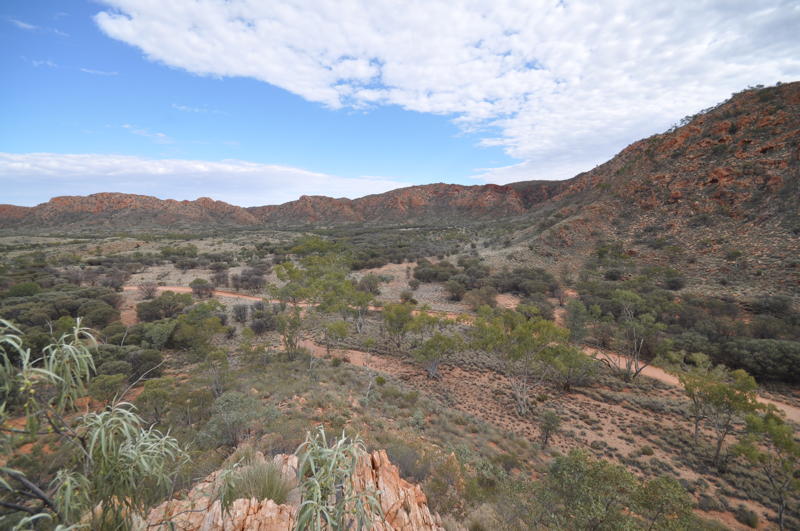
Today we saw lots of horse manure on the roadside, but didn’t see any horses, guess they had been marking their territory.
On our way to Kings Canyon: 150 km of dirt road. Stopped a few times to wait for traffic to pass, as its too dusty to drive behind other vehicles. At one point a convoy of 20 or more caravans passed, travelling at an irritating speed – we simply extended our break for an hour to ensure they were well ahead of us.
Early afternoon, we arrived at the Kings Canyon resort. The diesel price was $1.95 and there was a long queue to pay in the “Outback Oasis General Store”. We had 2 ice creams on the stick for $12.50. A man was unhappy that a bag of chips was $8 and expressed his distemper to the cashier. Come on, it is not easy to deliver goods to this place, you’re able to get them, should be happy, no matter what the price. I would be happy if they were free but that would never happen so I was glad that we could have that ice cream in such hot surroundings.
The campground was quite large, provided toilets, showers, a children’s playground, swimming pool, even coin washing machines. $20.20 per person per night.
Travelled from Kings Canyon to Uluru
First time to use an alarm clock on the trip to wake us up. Graham was to go on the Kings Canyon Rim track, a 6 km loop, 3-4 hour walk. It’s the walk that lots of people rave about. I didn’t want to do it because of the steep climb and cliffs, but Graham loves to walk, no walk is difficult nor too strenuous for him. I agreed that if he could go with a group, I would be glad to let him go without me – that was my safety precaution. Last night we went into the Kings Canyon resort 24/7 office, asked the staff if he could join a group, which was $25 to do the rim walk. The staff said it was too late to join the morning’s guided tour group, but that there would be lots of people around the track, so he wouldn’t be alone at all.
6.40 am: we left the campsite, it was already 23°C. If 36°C or more all guided tours would be cancelled.
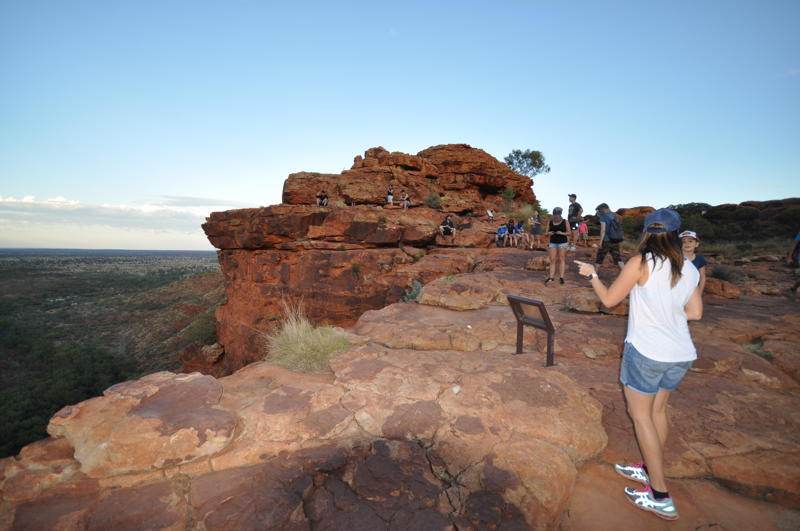
In this part of the world, dry heat doesn’t seem as hot as in Melbourne. I often walked in 30° plus heat with my sunhat on and extra shade from an umbrella, as long as I could stop for a while when I felt a bit dizzy, drinking water or almond milk seem to help too. When we walked around Rainbow Valley by mistake, it was in the afternoon 1 pm to 3.30 pm. I don’t think I could take a walk as exercise after it reaches 27°C in Melbourne.
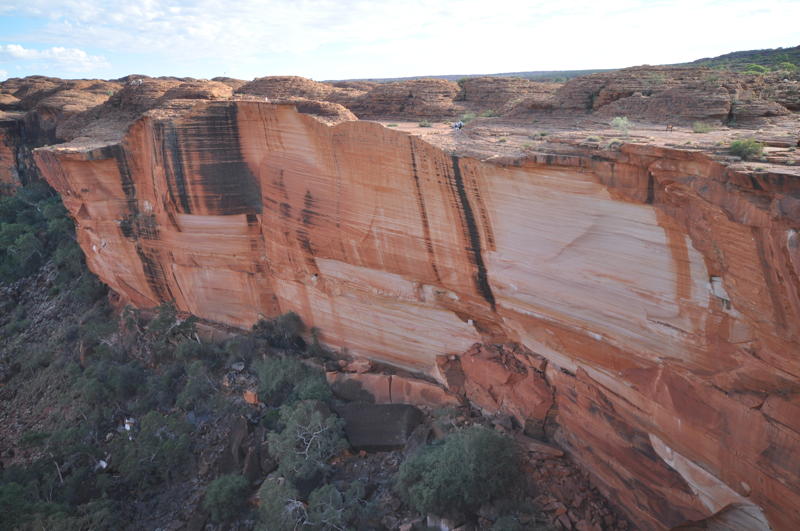
Flies bug me. They swarm around the face, particularly attracted to the moisture of the corner of the eyes, climb into my hair, following us when getting into the van. Once in the van, they fly around my ears. I had enough, start to kill them with the fly-swat. The windows looked like a battle ground, smeared with squashed flies; we bought a bottle of Windex to deal with the mess. They never bothered me at night though. Before sleeping, any active flies would fly around the light, so it was easy to get rid of them.
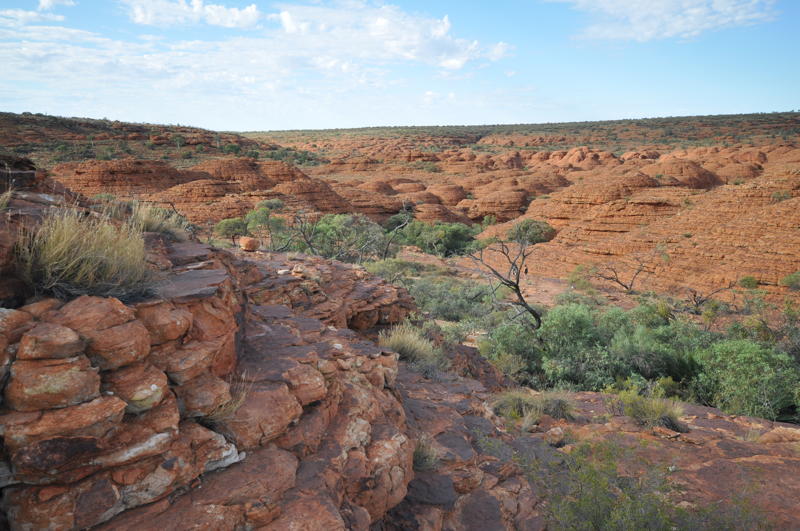
When the van stopped running at night or parked somewhere, a removable fan was added to the passenger’s window. Another two fans were permanently fixed at the end of the van, they were always running. Those fans keep the air moving gently throughout the van, sleep was never affected by the heat. A good rest at night is very important when travelling on the road, fatigue kills.
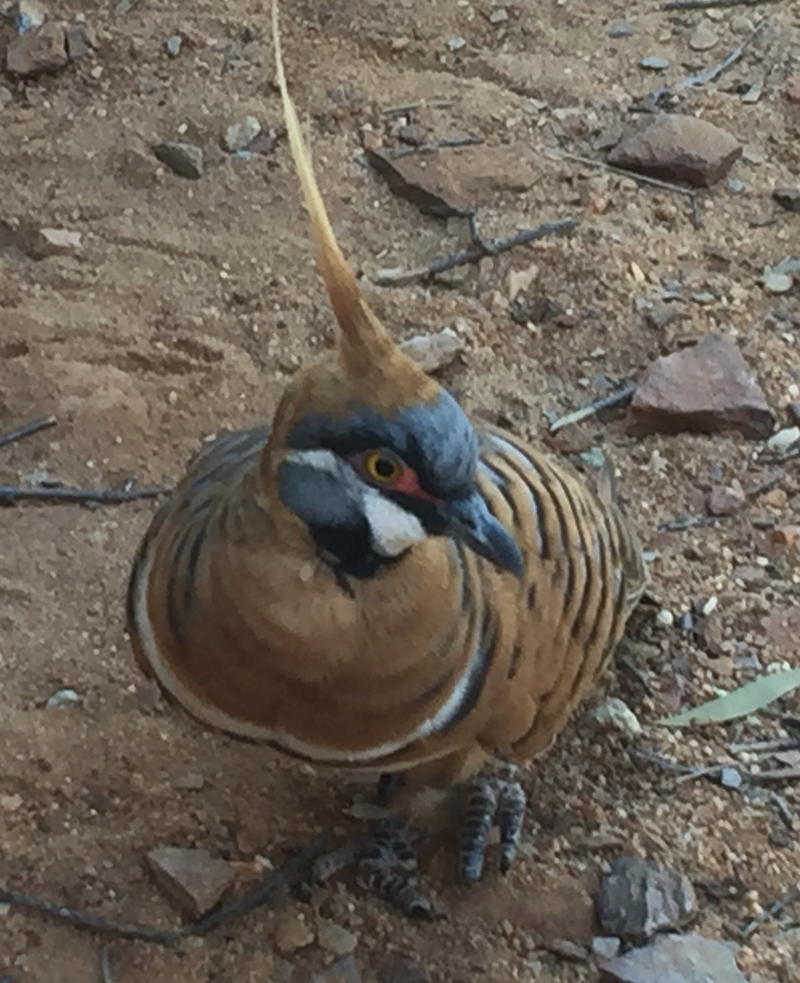
Although the van can carry 130 litres of water in tanks plus another 70 litres in various other containers, we topped up at petrol stations as it was free in most places (Coober Pedy was an exception). Most of the days we were far away from any township, conserving water was important. This is especially true with the way I wash, so Graham did most of the washing during the trip, he knows how to conserve water. I tried not to look at what he called “washing”, quietly standing next to him and drying the dishes.
I have long hair, reaching to the middle of my back, not easy to wash in the compact shower in the van. The best way was at the more formal campsites that featured a tap! Such a washing task became a luxurious moment. In the absence of such facilities Graham helped me to wash my hair in the kitchen sink, he did a better job than some hairdressers. After a few goes, this daily task became so easy, and it bought us so much laughter.
We stopped the van whenever we need a hot drink, there’s an espresso machine in the van so there was no compromise! When we wanted to enjoy some fruit, or a main meal, we just stopped and parked off the road. We had all the convenience of home. Never desperately looking for a toilet sign nor anxiously seeking an eating place. If someone loves to see the country, self-driving a van is without doubt the best way.
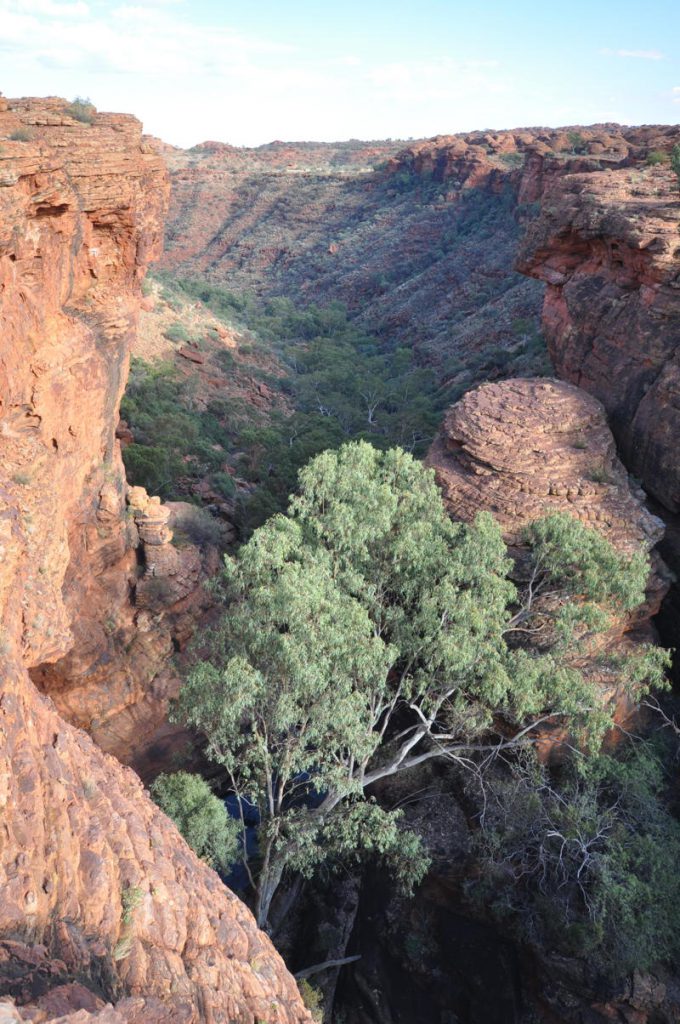
I love to experience nature, but my body has not adapted to harsh environments, so I tend to miss many opportunities. This tends to restrict my travelling companion too, poor Graham. This is another reason why self-drive is a good idea, I could do or not do by my own choice. You have no choice once you join a tour, following the tour can be a drag. Another good thing was being able to do as you like, no waiting for others.
There are lots of tour companies providing drop-off and pick-up services for those keen to do more than a day’s walking and camping in remote places that vehicles are unable to reach. Some drop off at one spot, then pick up at another spot. Graham did that in the past, I could see how much he wishes to do it again without him saying anything to me.
A van is far better than a caravan. Lots of places we went to would be slow and very difficult for caravans.
While Graham went on the Rim walk, I stayed in the van to update my notes, the fans working very well. I thought about going for a shorter walk on my own, but worry a bit about being on my own, so I passed. It got windy around 9 am, should be cooler for the people doing the Rim track.
By 9.25 am, Graham had returned to the van. We went back to the resort, had a shower.
Graham said he was exhilarated – mixed by the experience, climbing, views of the return trip, a cold shower, eating an orange and drinking a cup of good coffee – in that order. Something I wouldn’t feel in this trip. Were we really travelling together?
On the way to Uluru, we saw 23 mobile homes in a row pass us, pity didn’t think about taking some photos.
The road – I loved the pretty colour of the road and surrounds, red bitumen, green and grey roadside plants, blue sky with white clouds, feeling so good to be alive.
Arrived at Ayers Rock Resort. Booked in for 3 nights, $25 each night per van. Not as nice as last night’s Kings Canyon Resort. We could stay 15 to 20 km away from the Resort for free but we chose to stay here.
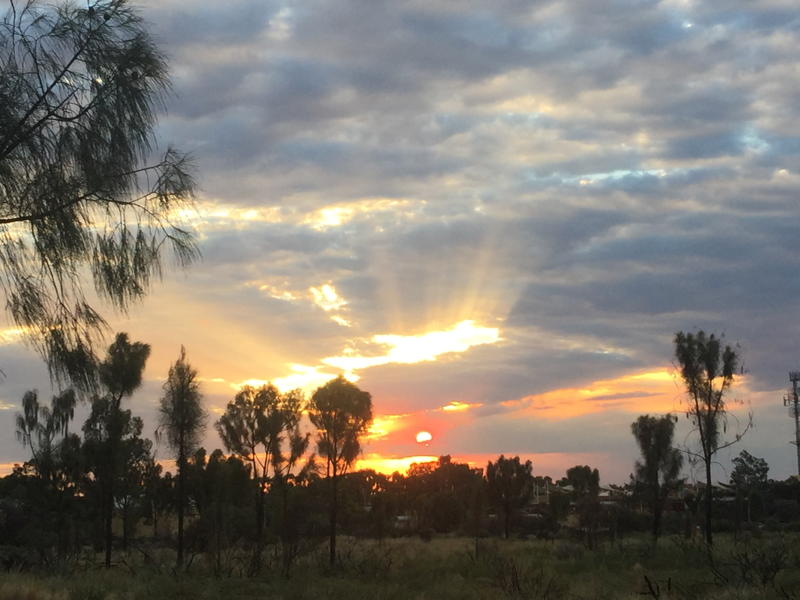
Travelled around Uluru & Kata Tjuta
I am really disappointed with Uluru’s and Ayers Rock Resort’s management. At 6 am we tried to go to Uluru, drove out from the Resort, there’s no sign that showed us where to go. Luckily many other cars were heading the same way, we blindly followed them, hoping we had done the right thing.
There was a long line of cars trying to get in, as we waited for our turn, there was no sign to show us anything. I thought that they at least should put signs up to show the entrance fee. I had checked on the internet before we left Melbourne, so I knew what they were. The line of cars moved very slowly, maybe most of the people didn’t know how much to pay, and it would be slowed down by those wishing to pay by cash.
At the resort reception, we couldn’t find any information about Uluru, which was a pity. It reminded me of a joke: The policeman asked “The other driver said that you didn’t give a signal when you turned, why didn’t you Bill?”. Bill answered “I’ve lived here for 50 years, by now everyone should know that I always make a right turn right here”.
Uluru had many signs telling visitors do not do this, do not do that. But it was really hard to find a sign to show us where to go. The whole place gave out pretty negative vibes, instead of the expected positive ambience. If the management really don’t like visitors, close the place up, stop visitors going in. Otherwise learn to be a good host, be visitor friendly or let those who know how to manage do the job.
We watched the sunrise, along with screaming and playful children and uncomfortable crying babies. Their parents didn’t want to compromise their experience so diminished it for others there to enjoy their Uluru spiritual moment. It wasn’t the peak tourist season, but every location that allowed visitors was packed with people. What can visitors do? Many areas were closed off. I am not saying that management shouldn’t close off some areas, I respect that some areas mean a lot to the land owners, so maybe the management should restrict the visitor numbers. Lots of visitors there were just keeping up with the Jones, didn’t seem to have any interest whatsoever in the place.
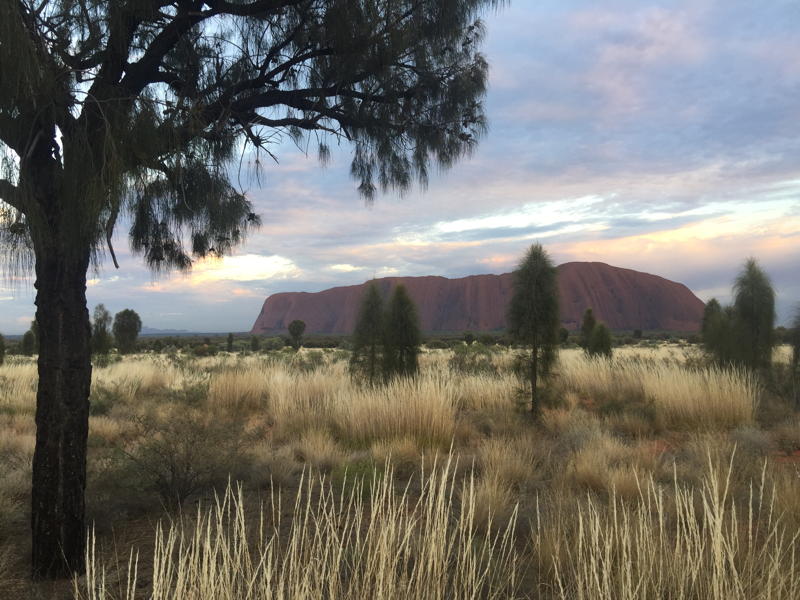
We wanted to go for the Uluru base walk but the car park was full. Many cars were double parked, I felt sorry for those cars who had lost their clear drive way. After a long walk in the heat, the last thing one would want to do is sit under the hot sun waiting for the other driver to turn up. There were many no parking signs along the roadside, yet many cars were parked in spite of the signs. I could understand why Uluru management didn’t care for visitors, from the entry to the road signs, the feeling I received was unhelpful; visitor behaviour must create lots of problems, or the other way around? We couldn’t park the car so we drove to the nearby Kata Tjuta (Olgas). They originated at a similar time as Uluru. They are thought to have originally been one massive monolith, as opposed to the 36 separate domes they are today. The Aboriginal people own the land, although the Australian government currently holds a 99-year lease.
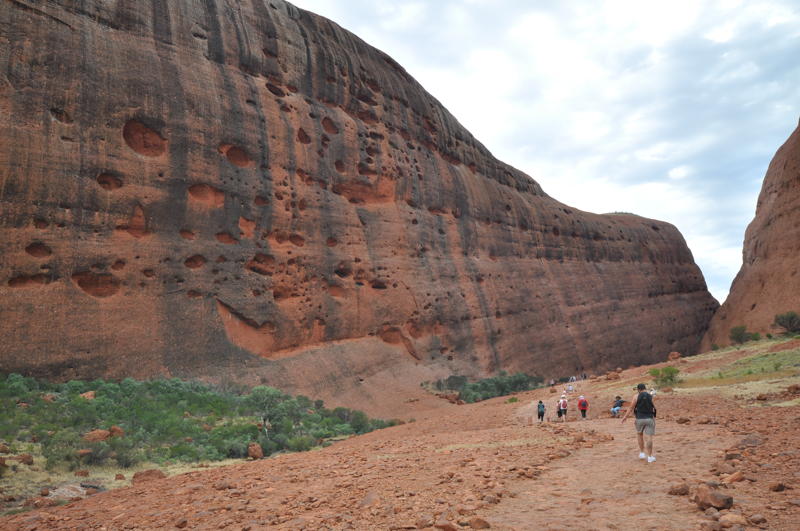
My memory of Kata Tjuta from a previous tour is still fresh in my mind. I was standing in front of a dome on my own. No fellow tourist to be seen. The dome towering into the sky, I was in its shadow. Totally immersed in the spirit of the area, no words could describe how deeply my heart felt, how much knowledge my brain had received. The primeval feeling made me humble, I felt insignificant, like I was walking into the truth. Aboriginal people have been trying to tell us for a long time, we in ignorance or wilful denial have pushed the falsehoods ahead, hoping they would become true. Don’t know how long I had that precious moment with the dome on my own but the feeling has never faded away. I was so looking forward to recapturing that feeling once more.
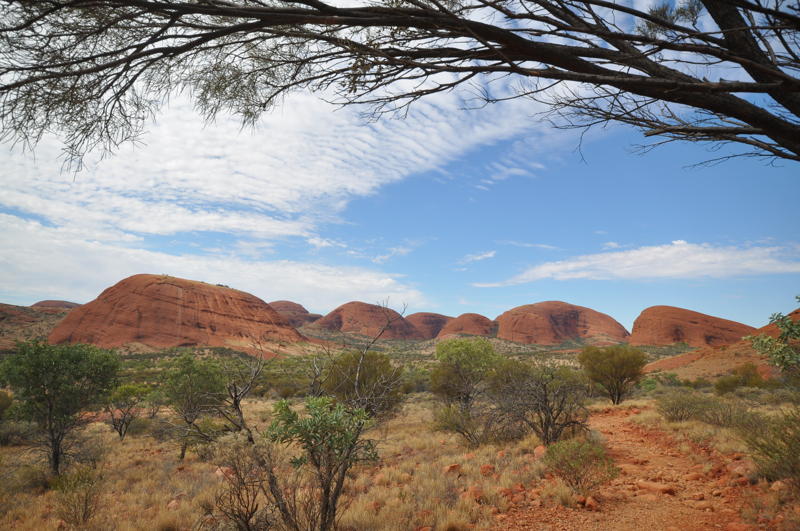
Before I made this second trip to the Red Centre, I thought I would learn a lot more of Aboriginal culture by revisiting Uluru and Kata Tjuta. It wasn’t the case.
The places allowing visitors were limited, the management closed most of the areas, so the areas that allowed visitors to get closer were filled with visitors. People were more interested in listening to their own voices then looking at the 600 million year old rock formations. Their verbal diarrhoea plus their neglected children’s crying, made the surrounding more like a second hand goods market than an ancient desert landscape. The sort of visitors there destroyed the essence of the area, which was a shame. Every time I was amongst the visitors, I felt like I was walking in a shopping centre – noisy, inconsiderate, clumsy, uncouth. With restrictions everywhere, it had lost its specialness, I was so terribly disappointed. A place like the Red Centre has its own character, temperament, feature and stamp; it won’t change much, even when our descendants become dust like us or our DNA has been wiped from the Earth. That’s how special it is, and how insignificant we are – it’s the truth, nothing but the truth, don’t feel too bad, it’s better to know than not.
Road signs were in Aboriginal language in the park, frequently long and difficult to pronounce, not visitor friendly. Lots of shops in the big international cities had foreign language signs, just to be friendly with their customers, that’s the business strategy.
Would like to see more Aboriginal people working on their own land, that would give out a positive impression of the place.
Valley of the wind had the best walk in Graham’s opinion. He enjoyed various waterholes, sacred meeting areas, numerous native birds, and native wild flowers along the desert trail. It was a 7.4 km loop, with a few slightly difficult sections. Watch out for heat exhaustion and dehydration in hot weather, carry plenty of water and finishing by 10 am is wise. I didn’t go far and soon returned to sit under the cover of a shelter near the car park, waiting for Graham’s return. I suffered 1.5 hours heat exhaustion, from which it took me days to recover; it was a situation that I won’t want to repeat.
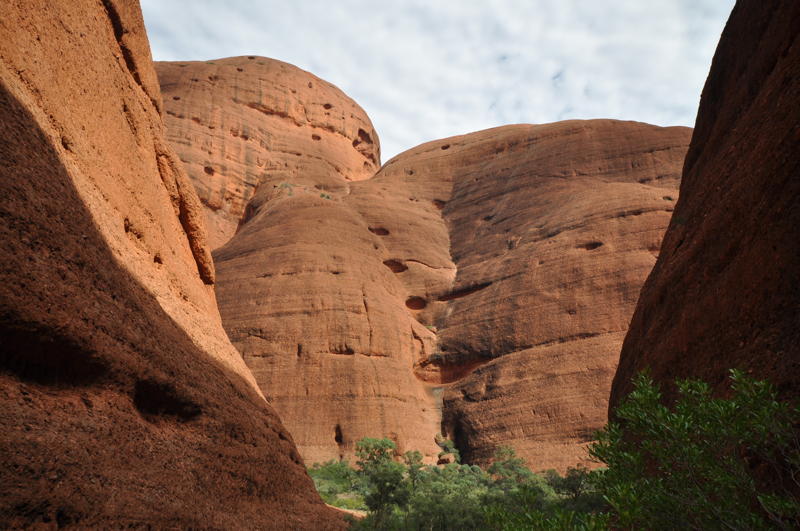
Everyone has different physical abilities; for some people like Graham, walking in the heat was nothing at all. Some people in the same condition may lose their lives. Please do take care of yourself, not worth taking the risk. The walking track would still be there next morning, go early and finish by 10 am, don’t fight with nature, at least think of your loved ones if you don’t care for your own wellbeing.
Returned to the Resort camp ground and showered. Wonderful!
There was a free air-conditioned shuttle bus around the Resort; we spent the hot afternoon using the shuttle to visit various attractions. The Astronomic shop was perhaps the most interesting, we watched a video that Graham had wanted to watch but hadn’t had a chance to until then. I’ve always loved the subject so it suited both of us. The lady in the shop looked like an astronomer, knowledgeable and helpful, impressing both Graham and I.
Walk around Uluru
When we reached the Uluru base walk car park, it was already packed with many cars. We started walking shortly before 7 am; including all the sidewalks, we covered about 12 km. It was one of the easiest walks of this trip. On flat land all the way, with a well-maintained path.
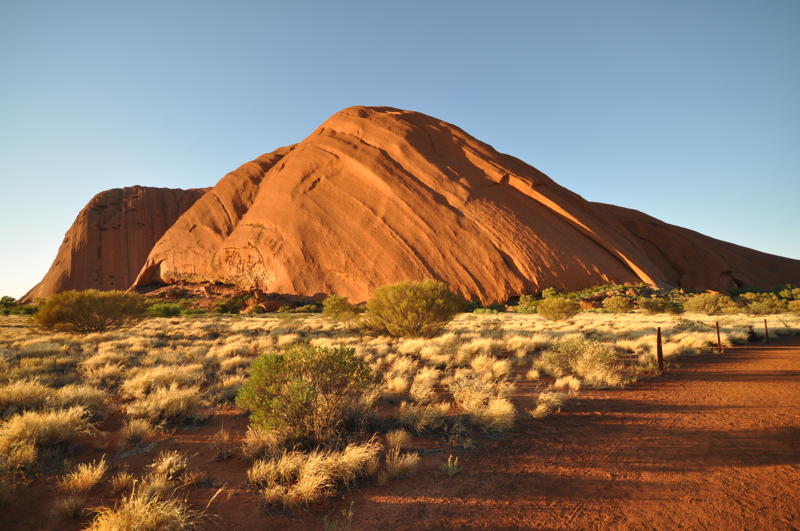
The surface of Uluru is made up of valleys, ridges, caves and weird shapes that were created through erosion over millions of years. Surface oxidation of its iron content gives the characteristic orange-red hue.
I remember a tour guide told us many years ago that some died while climbing Uluru, some die days or weeks after the climb. It was a hard task, the climbing path is about 1.6 km long and can be treacherous, only the first part has a chain to hold on to. The steep surface and strong wind can only be handled by the fit. Finally, the Uluru-Kata Tjuta National Park board announced the rock would be closed to climbers from October 26, 2019. Well done!
Thanks Graham, he respected the wishes of the owner of Uluru and didn’t fulfil his climbing dream.
Some young people’s behaviour around this World Heritage Site were a strange or unbelievable sight. A few were listening to pop music through ear phones, we could hear the music when they passed us, their eyes had either lost their focus or they looked at nothing. Some young teens focussed on their mobile phone, following behind their families. They did not want to be there, a waste of space!
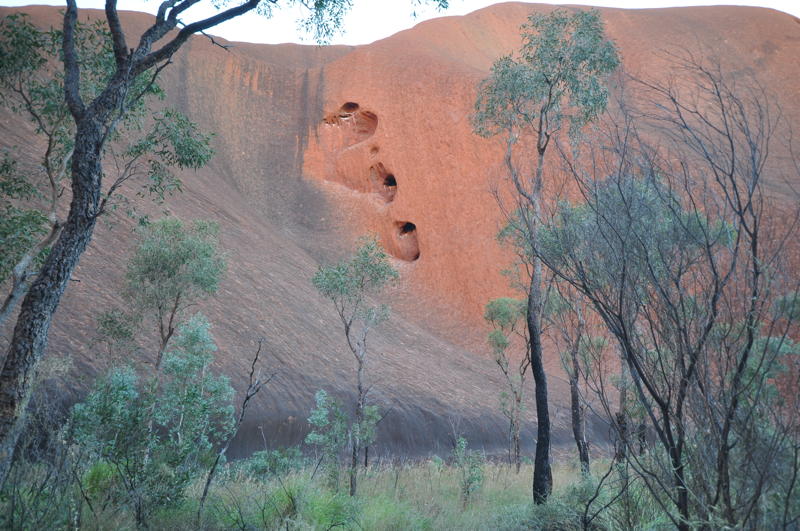
Not many people have a family able to take them to places like this, my personal opinion is all Australian children should be able to see and learn about Aboriginal culture and history. This is not just a tourist place; once in Uluru or Kata Tjuta, visitors should be quiet and absorb the environment. Lots of loud mouths around, ruined the spiritual feeling of the place, destroyed the spirit in Uluru and Kata Tjuta. I wish those people didn’t go there.
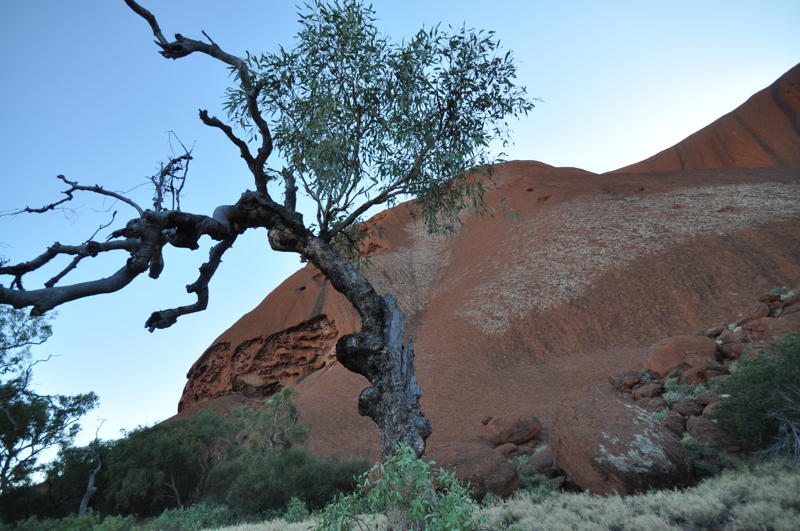
Saw a young man in his late teens or early 20s, running around the base with weights in both hands. We asked him when we saw him the second time whether he ran around the whole base; his answer was yes. He looked really fit, that’s the kind of young people we need in the world – healthy, mentally sound, alert and sharp.
He brightened my vision of the young generation.
The Culture Centre has no book about the place for sale nor any printed information for visitors. The video presenter had a flat voice, spoke softly with Aboriginal singing in the background, not easy to hear what she was trying to say. There was plenty of information on the wall, although much of it was superficial. One needs a photographic memory.
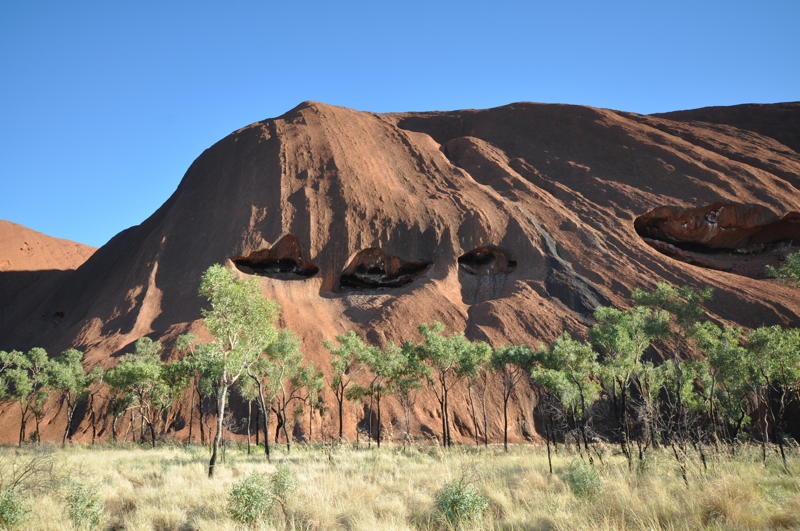
After we spent some time at the Culture Centre, we had a hamburger and chips for lunch. The food was poor quality, the choice of food was poor too. It made one feel that the management didn’t give a damn if one didn’t like the food. It’s not hard to provide visitors with something better; after hard walking, people yearn for something to satisfy the tummy, lots of people would willingly pay more for a decent meal. Pretty much like most sightseeing places, no reasonable food to eat.
Although we had paid to stay for 3 nights in Ayers Rock Resort, after less than 2 days we had had enough of that place, and left as soon as we could. On our way back to Melbourne.
A willy-willy suddenly appeared on the road while we were driving, it came towards the van without warning, forcing the van to swerve to the right then immediately to the left; we had no choice but to let it happen. It happened too quickly to be scared or worried, but it was fortunate there were no other cars on the road at that moment. The road and surrounds were flat; the worst thing that could happen was to roll the van, it was not life threatening. Actually, we both felt quite excited by the experience. It came so fast, we didn’t have the chance to take some shots to show and tell. Pity because this head-on experience with the willy-willy became one of the highlights of the trip.
We stayed overnight near Chandler – semi desert open bush by the creek about 1 km off the road. Had what appeared to be an old ochre quarry. Aboriginal people use ochre to paint and decorate. It had a pleasant waxy and cooling feel. We found three different colours – pure white, light yellow and a pinkish one.
Had my first open fire in the bush, cooked dinner, including sweet potatoes placed in the ashes just like Aboriginal people may have done.
It was a peaceful night with nature, with the Milky Way in all its magnificence, stars, a few meteorites and us. What more can anyone ask for?
Travelled from Chandler to Port Augusta
Travelling back to Melbourne, we took the same route back to Port Augusta. Different time, different weather and the opposite direction made the scenery look different too.
Today’s clouds had a purple tint, whereas a few days ago most of the day they looked white, one or two days had grey or black clouds.
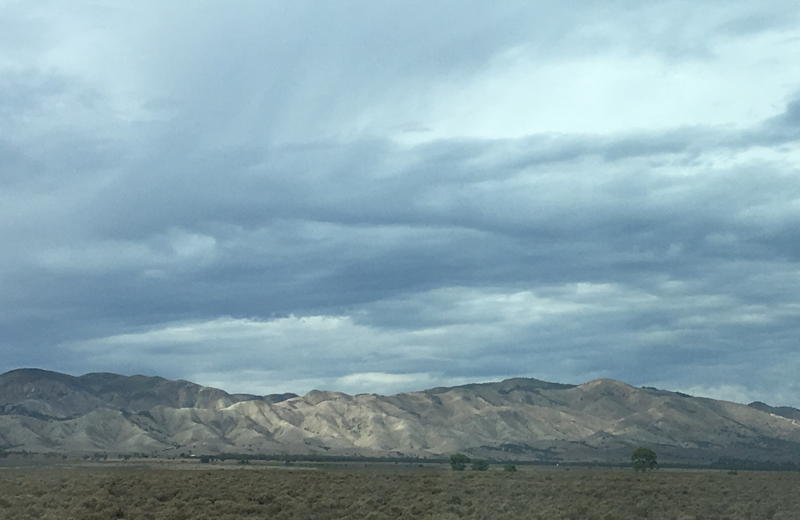
Towards the evening, cars quietened down on the road; most drivers took notice of the expert advice that staying put in the evening cut down road kill. On this road, between 5.50 pm to 5.55 pm five cars and one road train passed us from the opposite direction. Next 5 minutes had three cars and one road train. Following five minutes had two cars, two road trains. Seems most cars settle in at a campsite before sunset. Nice to know that Aussies are trying to do the right thing by the animals.
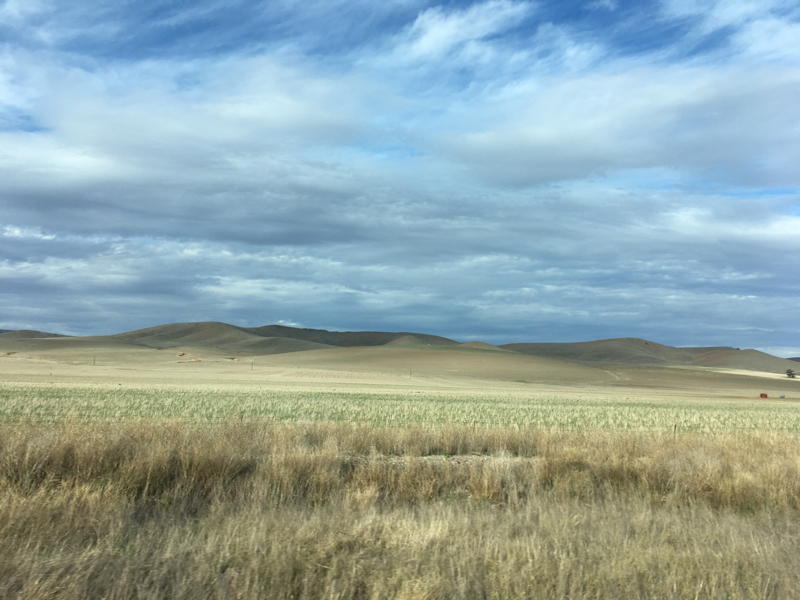
We decided to camp about 100 km short of Port Augusta.
Travelled from Port Augusta to Mildura
Before entering the fruit fly protected Renmark, we had to discard all our fruit in quarantine disposal bins. In the opposite direction, on entering the town, there were many quarantine roadblocks. They took the quarantine issue very seriously.
Fruit flies lay eggs in fruit and vegetables, rendering produce inedible and devastating crops. They can be spread by travellers carrying infested fruit into or between horticultural regions. Fruit and vegetable growers in Australia are under constant threat from the fruit fly. This pest has the potential to destroy a multi-million dollar fruit export industry that is vital to the survival of regional communities.
After arriving in Renmark, the first thing was to shop for fruit, then we walked around as tourists do.
Beware that before entering Mildura, the next major town, there’s another quarantine area that we didn’t know about. We had to discard some of the newly purchased fruit – you’ve got to do what you’ve got to do.
Near Orroroo, 35 km to Peterborough, standing gnarled and proud was a 500 year old giant River Red Gum tree. It has the nick name “Widow Maker” because this kind of tree has the habit of unexpectedly dropping large branches on timber workers below. The tree was about 10.4 metre in circumference and climbed about 7 metres before there was a fork in the trunk.
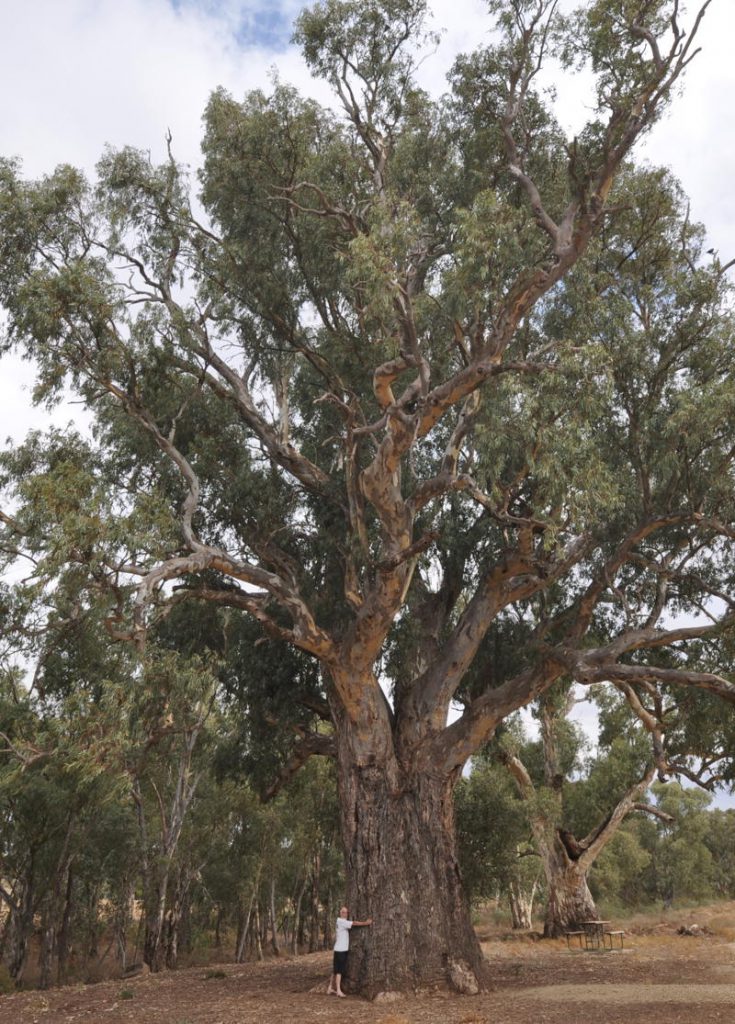
Travelled back to Melbourne
Passed through Mildura, spent some time at Ouyen. Changed to Melbourne time, which was 30 minutes later. Looked at a huge Mallee tree stump on display; it was the largest of 11 known black stumps in Australia. The impressive root system is 600 years old, weighs approximately 8 tonnes and 8m in diameter. It is located beside the Calder Highway in the heart of town.
The increasing traffic and the impatience of the drivers welcomed us back to the big city. If I didn’t long to see my loved ones, if I didn’t miss my comfortable home, I would have asked Graham “Shall we do a U turn?”
One of the best things to come home to is that we can look forward to and research the next trip.
I learnt a lot about the Australian dry centre, enjoying the openness and the cleanness which simply does not exist in the city. The Red Centre’s unaffected ambience, uncultivated land, genuine atmosphere and timeless setting are still alive in my mind. I didn’t capture much when I was there the first time, because I had not allowed myself to be immersed in the environment. This time I was in the right mood, and despite my heat exhaustion, managed to remain tuned into the country. I know I would relive the experience again and again, every time I think of the Red Centre.

